Wireless Charging Technology for Electric Vehicles
VerifiedAdded on 2020/03/15
|24
|4819
|500
AI Summary
This assignment delves into the emerging field of wireless power transfer for electric vehicles. It examines various inductive charging technologies, their applications in EV battery charging, and the potential impact on the transportation industry. The assignment also discusses the techno-economic feasibility, environmental implications, and future trends associated with wireless charging systems.
Contribute Materials
Your contribution can guide someone’s learning journey. Share your
documents today.
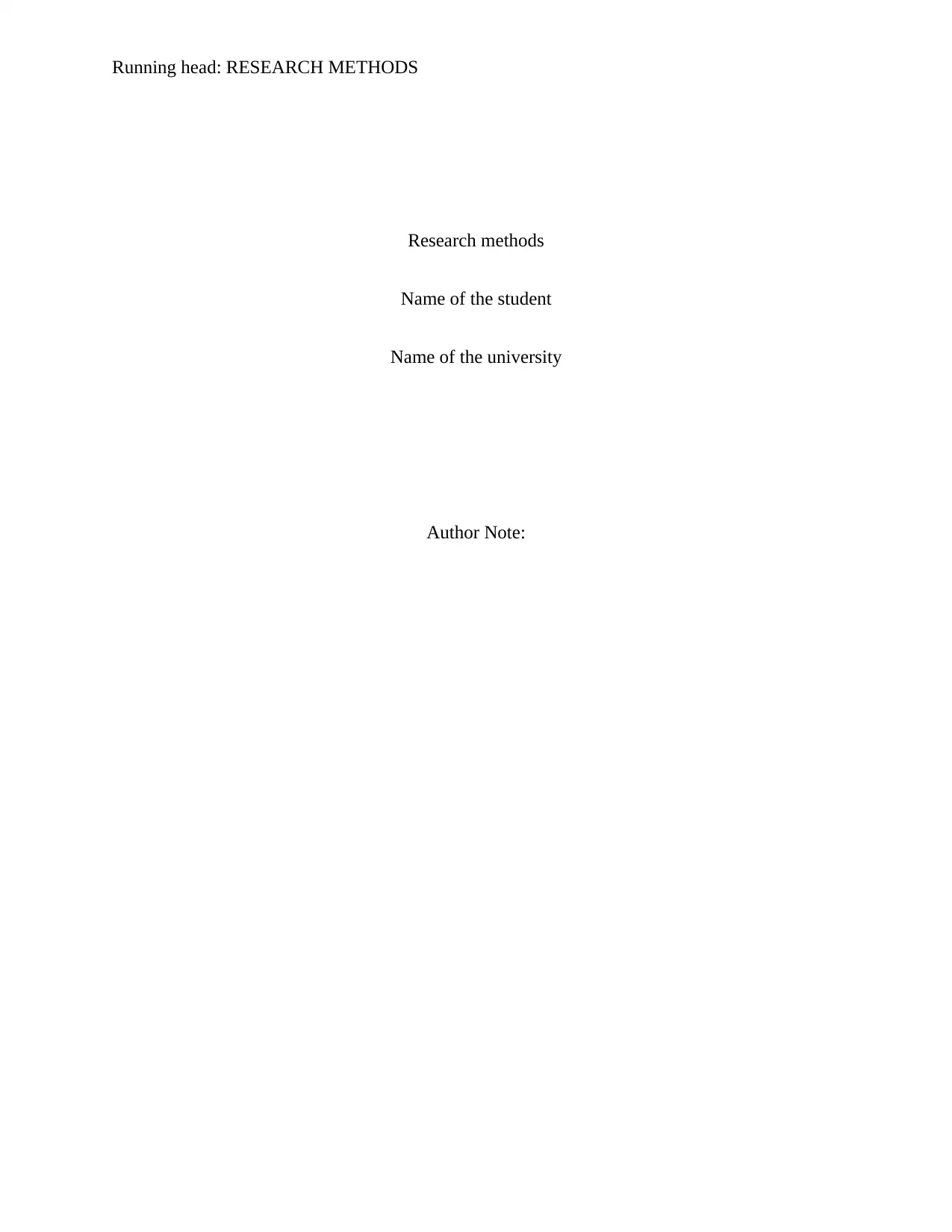
Running head: RESEARCH METHODS
Research methods
Name of the student
Name of the university
Author Note:
Research methods
Name of the student
Name of the university
Author Note:
Secure Best Marks with AI Grader
Need help grading? Try our AI Grader for instant feedback on your assignments.

2
RESEARCH METHODS
Table of Contents
Abstract............................................................................................................................................4
Introduction......................................................................................................................................5
Literature Review............................................................................................................................5
Overview..........................................................................................................................................5
Conceptual Framework....................................................................................................................6
Figure 1- Conceptual Framework....................................................................................................6
Definition of Wireless Charging Facilities......................................................................................7
Critical Analysis..............................................................................................................................8
Advantages and Disadvantages.....................................................................................................10
Research Design............................................................................................................................11
Research Questions........................................................................................................................11
Qualitative Research......................................................................................................................12
Quantitative Research....................................................................................................................13
Sample size....................................................................................................................................13
Research Limitations.....................................................................................................................14
Design Questions...........................................................................................................................15
Experimental and correlation designs............................................................................................16
Strengths and Weakness................................................................................................................16
RESEARCH METHODS
Table of Contents
Abstract............................................................................................................................................4
Introduction......................................................................................................................................5
Literature Review............................................................................................................................5
Overview..........................................................................................................................................5
Conceptual Framework....................................................................................................................6
Figure 1- Conceptual Framework....................................................................................................6
Definition of Wireless Charging Facilities......................................................................................7
Critical Analysis..............................................................................................................................8
Advantages and Disadvantages.....................................................................................................10
Research Design............................................................................................................................11
Research Questions........................................................................................................................11
Qualitative Research......................................................................................................................12
Quantitative Research....................................................................................................................13
Sample size....................................................................................................................................13
Research Limitations.....................................................................................................................14
Design Questions...........................................................................................................................15
Experimental and correlation designs............................................................................................16
Strengths and Weakness................................................................................................................16
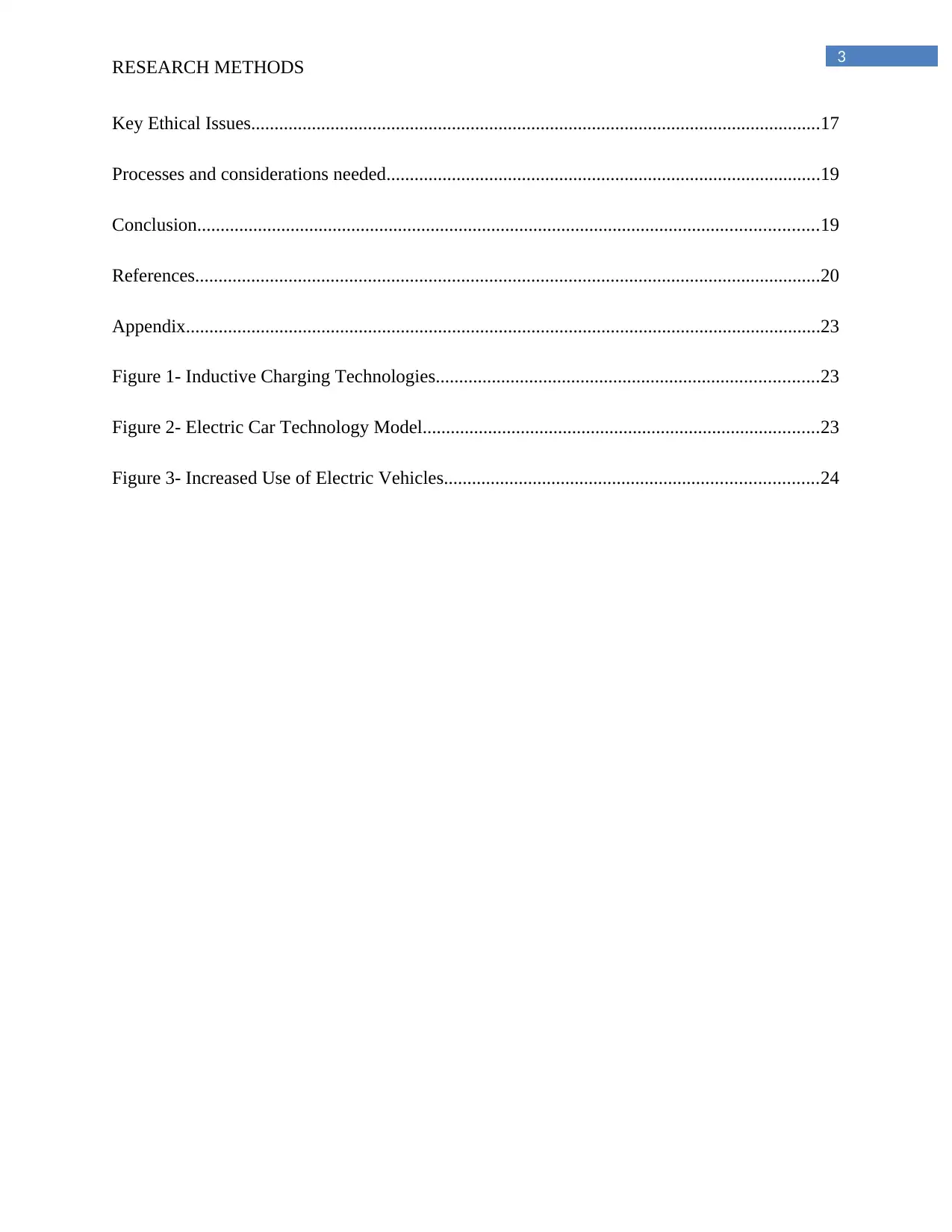
3
RESEARCH METHODS
Key Ethical Issues..........................................................................................................................17
Processes and considerations needed.............................................................................................19
Conclusion.....................................................................................................................................19
References......................................................................................................................................20
Appendix........................................................................................................................................23
Figure 1- Inductive Charging Technologies..................................................................................23
Figure 2- Electric Car Technology Model.....................................................................................23
Figure 3- Increased Use of Electric Vehicles................................................................................24
RESEARCH METHODS
Key Ethical Issues..........................................................................................................................17
Processes and considerations needed.............................................................................................19
Conclusion.....................................................................................................................................19
References......................................................................................................................................20
Appendix........................................................................................................................................23
Figure 1- Inductive Charging Technologies..................................................................................23
Figure 2- Electric Car Technology Model.....................................................................................23
Figure 3- Increased Use of Electric Vehicles................................................................................24

4
RESEARCH METHODS
Abstract
The topic of the following research is Battery and wireless charging for cars. The researcher has
chosen quite an uncommon topic that deals with one of the latest technologies involving the
revolutionizing the transport sector of the world by promoting green forms of energy and
reducing the use of oil and also curbing the pollution level. As mentioned earlier the research is
important as because very few researchers have earlier ventured into such a research and thus the
research that has been conducted stands out to be one of the sought after by any researchers who
would be undertaking a similar research. The research has been conducted mainly on a
qualitative environment but some quantitative factors were also involved during the conduction
of the research. The researcher has conducted the research ethically and was honest and effective
in every single approach of the research. After a thorough analysis of the research it was seen
that the potential aims and objectives of the research were met. The readers after going through
the research in detail can help them learn a great deal about wireless electric car charging
technology, renewable energy sources and many more as such. As a result it can be
recommended that the research is very useful and a successful piece of work by the researcher.
RESEARCH METHODS
Abstract
The topic of the following research is Battery and wireless charging for cars. The researcher has
chosen quite an uncommon topic that deals with one of the latest technologies involving the
revolutionizing the transport sector of the world by promoting green forms of energy and
reducing the use of oil and also curbing the pollution level. As mentioned earlier the research is
important as because very few researchers have earlier ventured into such a research and thus the
research that has been conducted stands out to be one of the sought after by any researchers who
would be undertaking a similar research. The research has been conducted mainly on a
qualitative environment but some quantitative factors were also involved during the conduction
of the research. The researcher has conducted the research ethically and was honest and effective
in every single approach of the research. After a thorough analysis of the research it was seen
that the potential aims and objectives of the research were met. The readers after going through
the research in detail can help them learn a great deal about wireless electric car charging
technology, renewable energy sources and many more as such. As a result it can be
recommended that the research is very useful and a successful piece of work by the researcher.
Secure Best Marks with AI Grader
Need help grading? Try our AI Grader for instant feedback on your assignments.
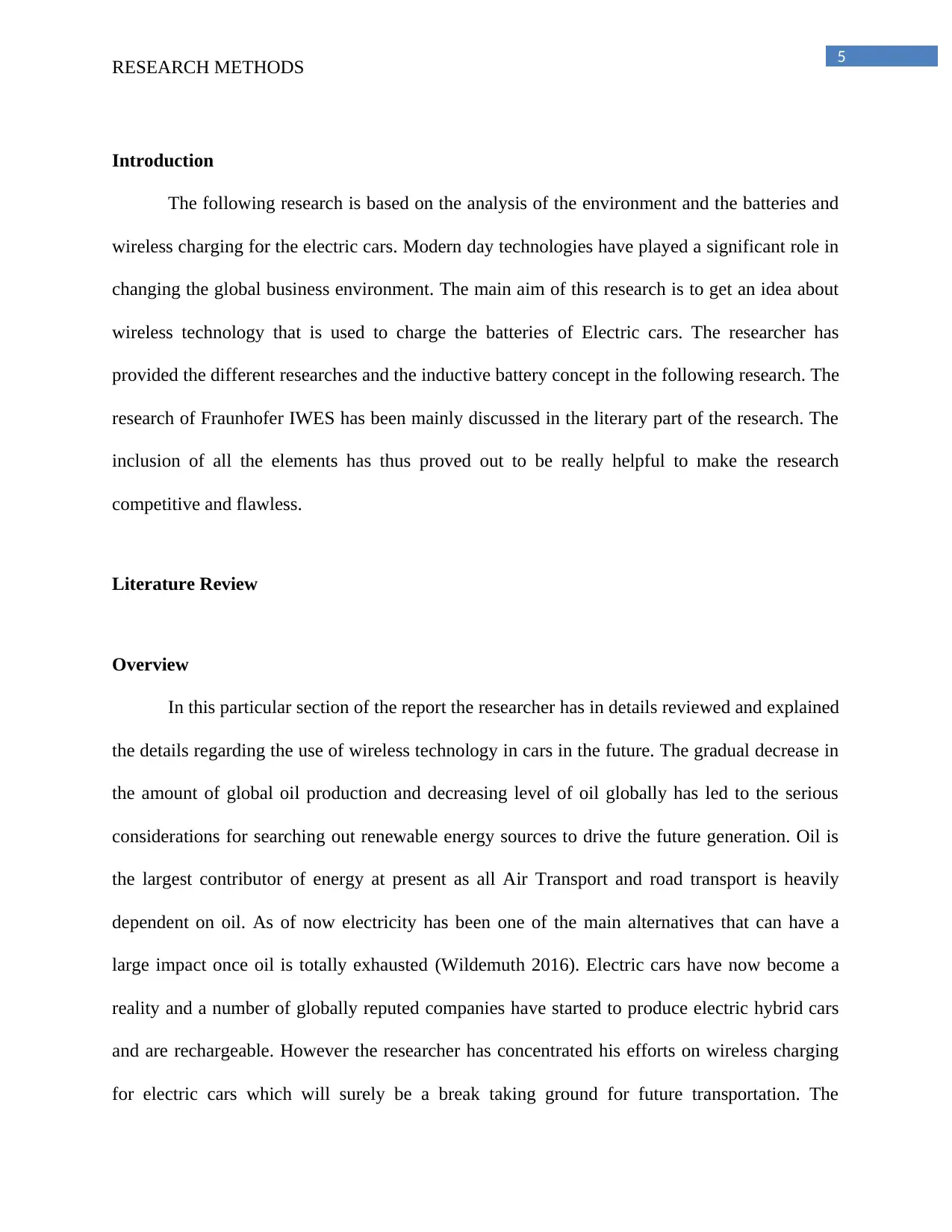
5
RESEARCH METHODS
Introduction
The following research is based on the analysis of the environment and the batteries and
wireless charging for the electric cars. Modern day technologies have played a significant role in
changing the global business environment. The main aim of this research is to get an idea about
wireless technology that is used to charge the batteries of Electric cars. The researcher has
provided the different researches and the inductive battery concept in the following research. The
research of Fraunhofer IWES has been mainly discussed in the literary part of the research. The
inclusion of all the elements has thus proved out to be really helpful to make the research
competitive and flawless.
Literature Review
Overview
In this particular section of the report the researcher has in details reviewed and explained
the details regarding the use of wireless technology in cars in the future. The gradual decrease in
the amount of global oil production and decreasing level of oil globally has led to the serious
considerations for searching out renewable energy sources to drive the future generation. Oil is
the largest contributor of energy at present as all Air Transport and road transport is heavily
dependent on oil. As of now electricity has been one of the main alternatives that can have a
large impact once oil is totally exhausted (Wildemuth 2016). Electric cars have now become a
reality and a number of globally reputed companies have started to produce electric hybrid cars
and are rechargeable. However the researcher has concentrated his efforts on wireless charging
for electric cars which will surely be a break taking ground for future transportation. The
RESEARCH METHODS
Introduction
The following research is based on the analysis of the environment and the batteries and
wireless charging for the electric cars. Modern day technologies have played a significant role in
changing the global business environment. The main aim of this research is to get an idea about
wireless technology that is used to charge the batteries of Electric cars. The researcher has
provided the different researches and the inductive battery concept in the following research. The
research of Fraunhofer IWES has been mainly discussed in the literary part of the research. The
inclusion of all the elements has thus proved out to be really helpful to make the research
competitive and flawless.
Literature Review
Overview
In this particular section of the report the researcher has in details reviewed and explained
the details regarding the use of wireless technology in cars in the future. The gradual decrease in
the amount of global oil production and decreasing level of oil globally has led to the serious
considerations for searching out renewable energy sources to drive the future generation. Oil is
the largest contributor of energy at present as all Air Transport and road transport is heavily
dependent on oil. As of now electricity has been one of the main alternatives that can have a
large impact once oil is totally exhausted (Wildemuth 2016). Electric cars have now become a
reality and a number of globally reputed companies have started to produce electric hybrid cars
and are rechargeable. However the researcher has concentrated his efforts on wireless charging
for electric cars which will surely be a break taking ground for future transportation. The
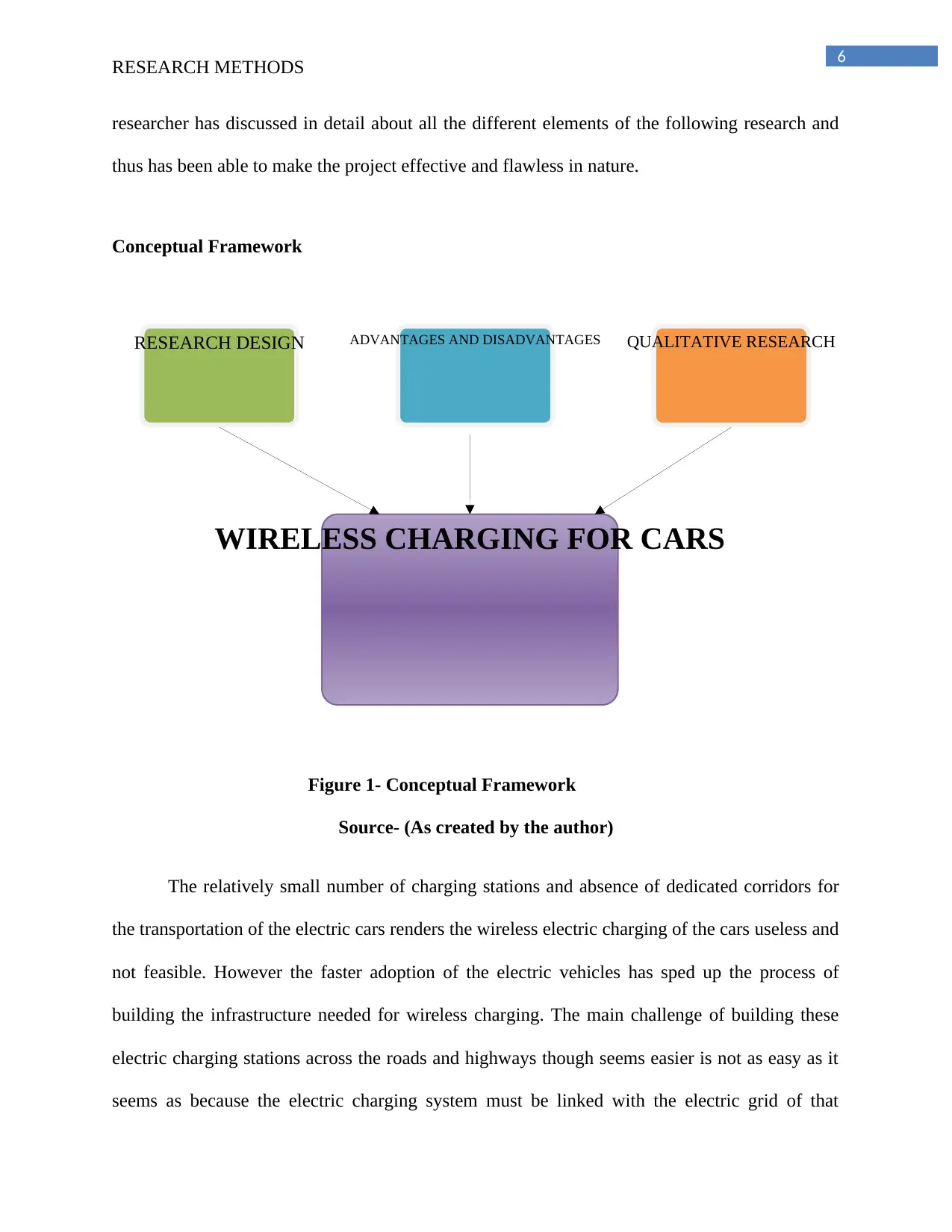
6
WIRELESS CHARGING FOR CARS
RESEARCH DESIGN ADVANTAGES AND DISADVANTAGES QUALITATIVE RESEARCH
RESEARCH METHODS
researcher has discussed in detail about all the different elements of the following research and
thus has been able to make the project effective and flawless in nature.
Conceptual Framework
Figure 1- Conceptual Framework
Source- (As created by the author)
The relatively small number of charging stations and absence of dedicated corridors for
the transportation of the electric cars renders the wireless electric charging of the cars useless and
not feasible. However the faster adoption of the electric vehicles has sped up the process of
building the infrastructure needed for wireless charging. The main challenge of building these
electric charging stations across the roads and highways though seems easier is not as easy as it
seems as because the electric charging system must be linked with the electric grid of that
WIRELESS CHARGING FOR CARS
RESEARCH DESIGN ADVANTAGES AND DISADVANTAGES QUALITATIVE RESEARCH
RESEARCH METHODS
researcher has discussed in detail about all the different elements of the following research and
thus has been able to make the project effective and flawless in nature.
Conceptual Framework
Figure 1- Conceptual Framework
Source- (As created by the author)
The relatively small number of charging stations and absence of dedicated corridors for
the transportation of the electric cars renders the wireless electric charging of the cars useless and
not feasible. However the faster adoption of the electric vehicles has sped up the process of
building the infrastructure needed for wireless charging. The main challenge of building these
electric charging stations across the roads and highways though seems easier is not as easy as it
seems as because the electric charging system must be linked with the electric grid of that
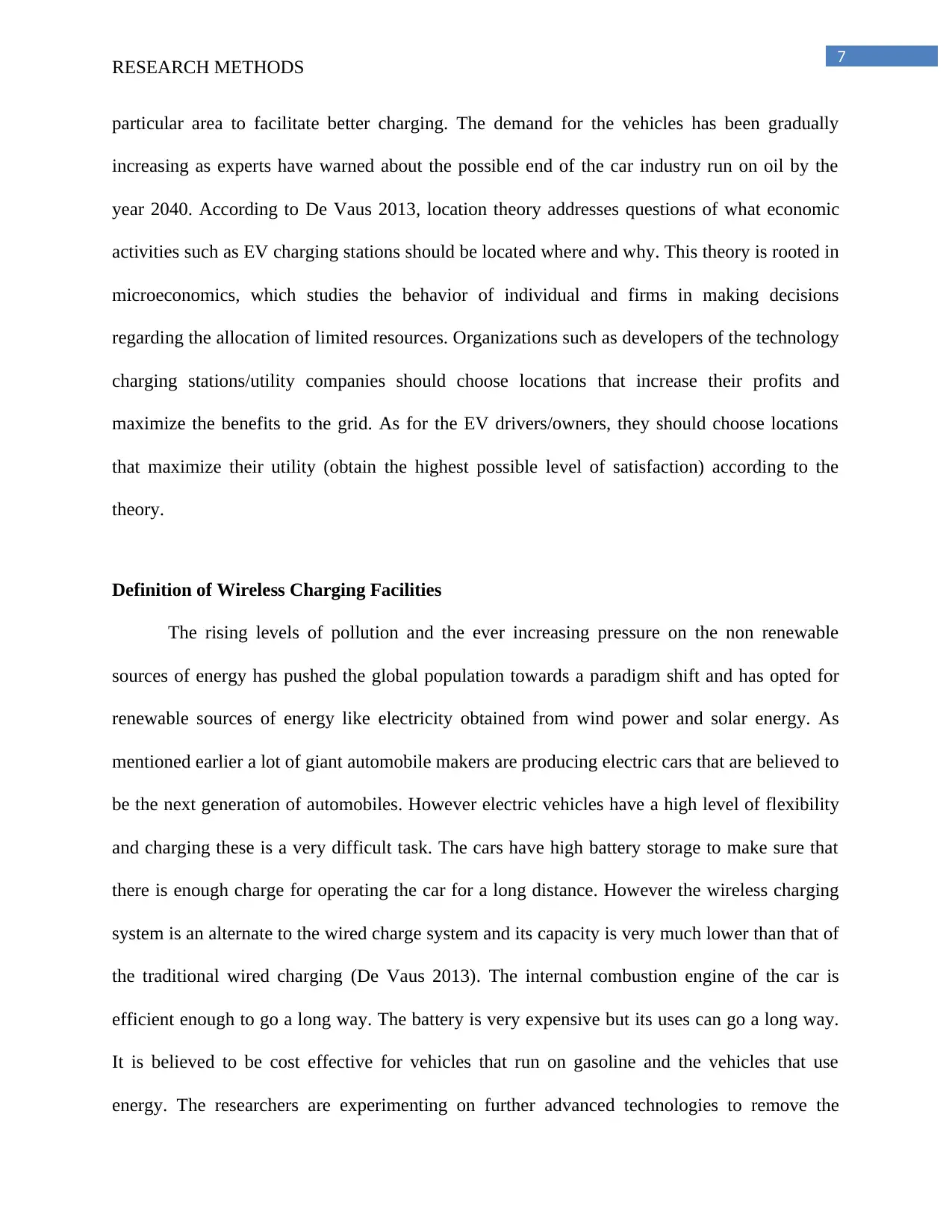
7
RESEARCH METHODS
particular area to facilitate better charging. The demand for the vehicles has been gradually
increasing as experts have warned about the possible end of the car industry run on oil by the
year 2040. According to De Vaus 2013, location theory addresses questions of what economic
activities such as EV charging stations should be located where and why. This theory is rooted in
microeconomics, which studies the behavior of individual and firms in making decisions
regarding the allocation of limited resources. Organizations such as developers of the technology
charging stations/utility companies should choose locations that increase their profits and
maximize the benefits to the grid. As for the EV drivers/owners, they should choose locations
that maximize their utility (obtain the highest possible level of satisfaction) according to the
theory.
Definition of Wireless Charging Facilities
The rising levels of pollution and the ever increasing pressure on the non renewable
sources of energy has pushed the global population towards a paradigm shift and has opted for
renewable sources of energy like electricity obtained from wind power and solar energy. As
mentioned earlier a lot of giant automobile makers are producing electric cars that are believed to
be the next generation of automobiles. However electric vehicles have a high level of flexibility
and charging these is a very difficult task. The cars have high battery storage to make sure that
there is enough charge for operating the car for a long distance. However the wireless charging
system is an alternate to the wired charge system and its capacity is very much lower than that of
the traditional wired charging (De Vaus 2013). The internal combustion engine of the car is
efficient enough to go a long way. The battery is very expensive but its uses can go a long way.
It is believed to be cost effective for vehicles that run on gasoline and the vehicles that use
energy. The researchers are experimenting on further advanced technologies to remove the
RESEARCH METHODS
particular area to facilitate better charging. The demand for the vehicles has been gradually
increasing as experts have warned about the possible end of the car industry run on oil by the
year 2040. According to De Vaus 2013, location theory addresses questions of what economic
activities such as EV charging stations should be located where and why. This theory is rooted in
microeconomics, which studies the behavior of individual and firms in making decisions
regarding the allocation of limited resources. Organizations such as developers of the technology
charging stations/utility companies should choose locations that increase their profits and
maximize the benefits to the grid. As for the EV drivers/owners, they should choose locations
that maximize their utility (obtain the highest possible level of satisfaction) according to the
theory.
Definition of Wireless Charging Facilities
The rising levels of pollution and the ever increasing pressure on the non renewable
sources of energy has pushed the global population towards a paradigm shift and has opted for
renewable sources of energy like electricity obtained from wind power and solar energy. As
mentioned earlier a lot of giant automobile makers are producing electric cars that are believed to
be the next generation of automobiles. However electric vehicles have a high level of flexibility
and charging these is a very difficult task. The cars have high battery storage to make sure that
there is enough charge for operating the car for a long distance. However the wireless charging
system is an alternate to the wired charge system and its capacity is very much lower than that of
the traditional wired charging (De Vaus 2013). The internal combustion engine of the car is
efficient enough to go a long way. The battery is very expensive but its uses can go a long way.
It is believed to be cost effective for vehicles that run on gasoline and the vehicles that use
energy. The researchers are experimenting on further advanced technologies to remove the
Paraphrase This Document
Need a fresh take? Get an instant paraphrase of this document with our AI Paraphraser
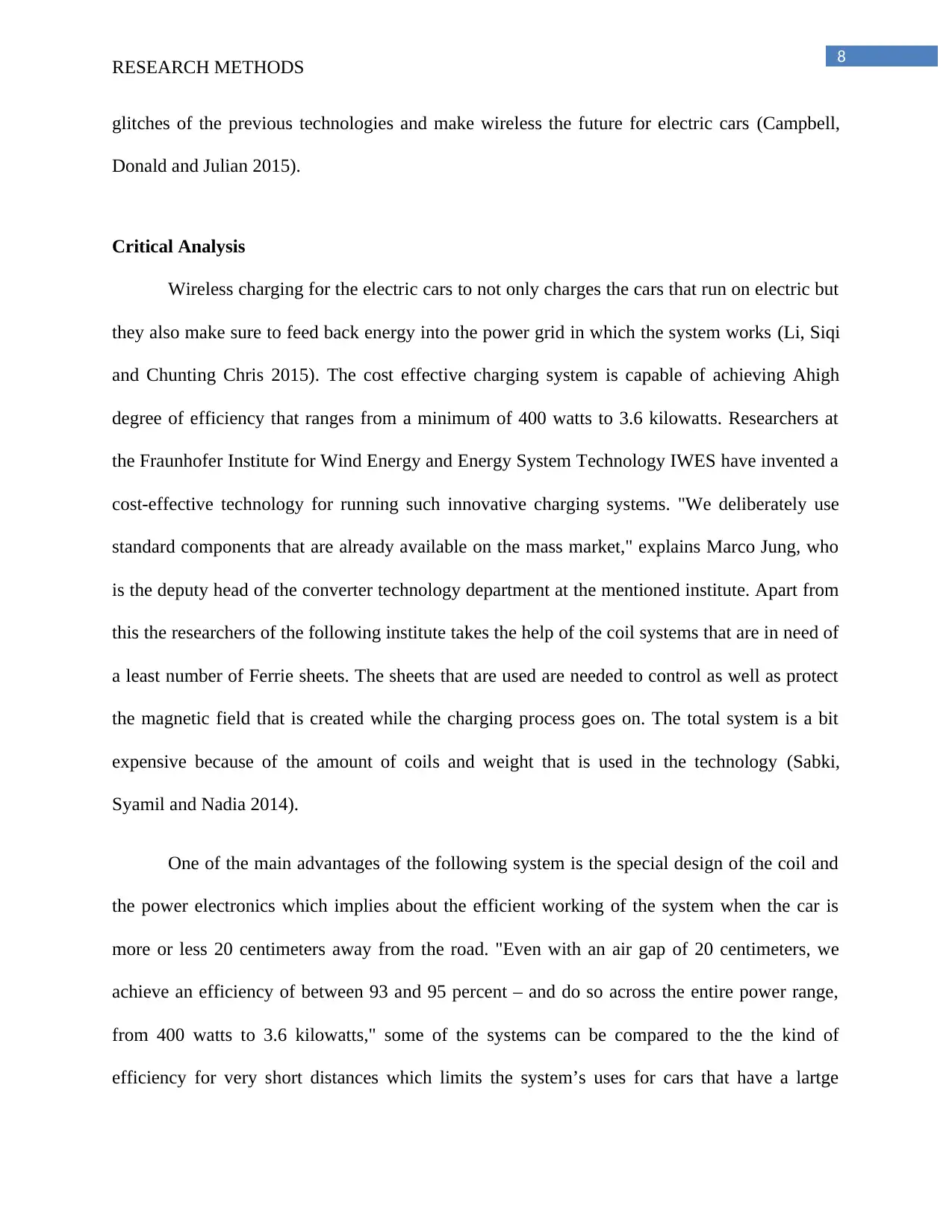
8
RESEARCH METHODS
glitches of the previous technologies and make wireless the future for electric cars (Campbell,
Donald and Julian 2015).
Critical Analysis
Wireless charging for the electric cars to not only charges the cars that run on electric but
they also make sure to feed back energy into the power grid in which the system works (Li, Siqi
and Chunting Chris 2015). The cost effective charging system is capable of achieving Ahigh
degree of efficiency that ranges from a minimum of 400 watts to 3.6 kilowatts. Researchers at
the Fraunhofer Institute for Wind Energy and Energy System Technology IWES have invented a
cost-effective technology for running such innovative charging systems. "We deliberately use
standard components that are already available on the mass market," explains Marco Jung, who
is the deputy head of the converter technology department at the mentioned institute. Apart from
this the researchers of the following institute takes the help of the coil systems that are in need of
a least number of Ferrie sheets. The sheets that are used are needed to control as well as protect
the magnetic field that is created while the charging process goes on. The total system is a bit
expensive because of the amount of coils and weight that is used in the technology (Sabki,
Syamil and Nadia 2014).
One of the main advantages of the following system is the special design of the coil and
the power electronics which implies about the efficient working of the system when the car is
more or less 20 centimeters away from the road. "Even with an air gap of 20 centimeters, we
achieve an efficiency of between 93 and 95 percent – and do so across the entire power range,
from 400 watts to 3.6 kilowatts," some of the systems can be compared to the the kind of
efficiency for very short distances which limits the system’s uses for cars that have a lartge
RESEARCH METHODS
glitches of the previous technologies and make wireless the future for electric cars (Campbell,
Donald and Julian 2015).
Critical Analysis
Wireless charging for the electric cars to not only charges the cars that run on electric but
they also make sure to feed back energy into the power grid in which the system works (Li, Siqi
and Chunting Chris 2015). The cost effective charging system is capable of achieving Ahigh
degree of efficiency that ranges from a minimum of 400 watts to 3.6 kilowatts. Researchers at
the Fraunhofer Institute for Wind Energy and Energy System Technology IWES have invented a
cost-effective technology for running such innovative charging systems. "We deliberately use
standard components that are already available on the mass market," explains Marco Jung, who
is the deputy head of the converter technology department at the mentioned institute. Apart from
this the researchers of the following institute takes the help of the coil systems that are in need of
a least number of Ferrie sheets. The sheets that are used are needed to control as well as protect
the magnetic field that is created while the charging process goes on. The total system is a bit
expensive because of the amount of coils and weight that is used in the technology (Sabki,
Syamil and Nadia 2014).
One of the main advantages of the following system is the special design of the coil and
the power electronics which implies about the efficient working of the system when the car is
more or less 20 centimeters away from the road. "Even with an air gap of 20 centimeters, we
achieve an efficiency of between 93 and 95 percent – and do so across the entire power range,
from 400 watts to 3.6 kilowatts," some of the systems can be compared to the the kind of
efficiency for very short distances which limits the system’s uses for cars that have a lartge
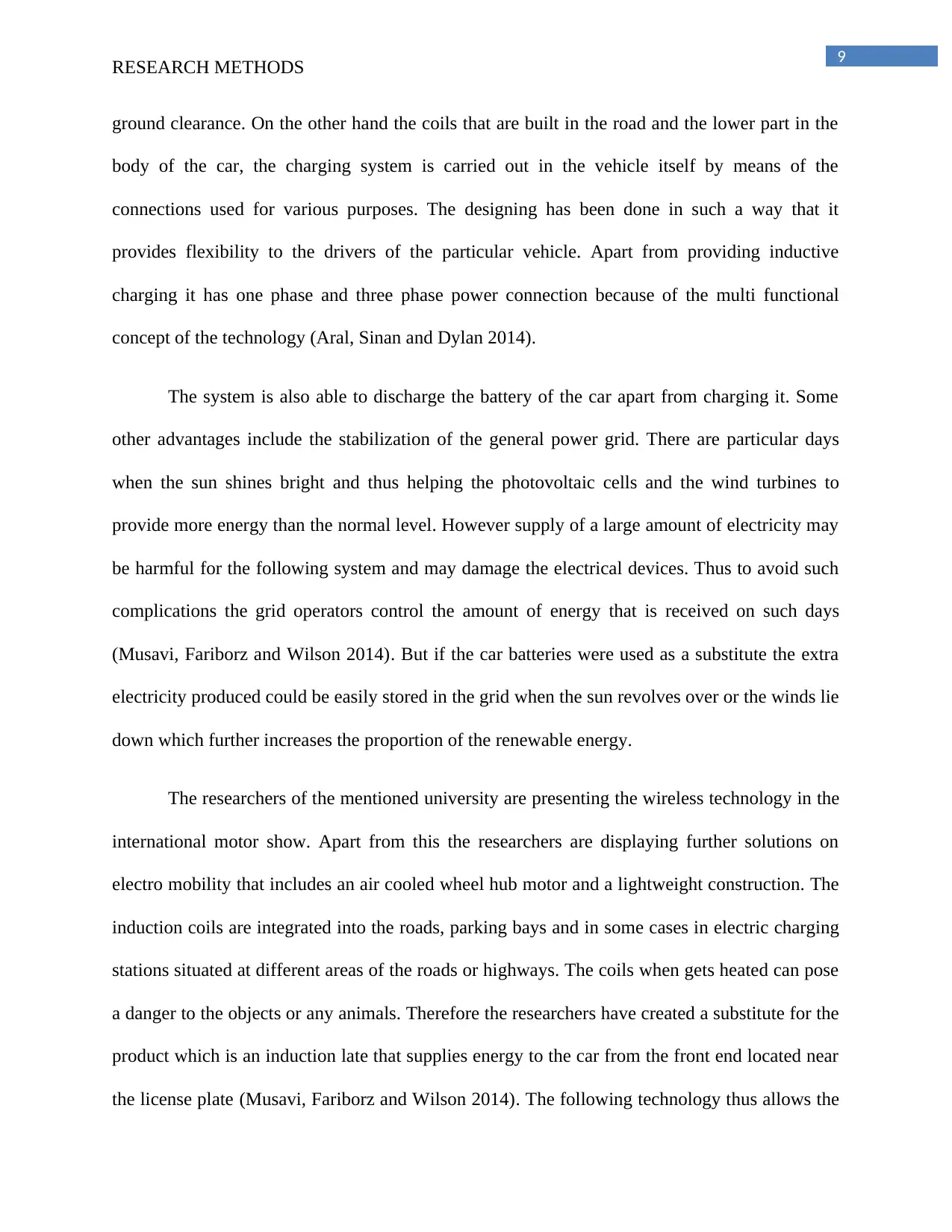
9
RESEARCH METHODS
ground clearance. On the other hand the coils that are built in the road and the lower part in the
body of the car, the charging system is carried out in the vehicle itself by means of the
connections used for various purposes. The designing has been done in such a way that it
provides flexibility to the drivers of the particular vehicle. Apart from providing inductive
charging it has one phase and three phase power connection because of the multi functional
concept of the technology (Aral, Sinan and Dylan 2014).
The system is also able to discharge the battery of the car apart from charging it. Some
other advantages include the stabilization of the general power grid. There are particular days
when the sun shines bright and thus helping the photovoltaic cells and the wind turbines to
provide more energy than the normal level. However supply of a large amount of electricity may
be harmful for the following system and may damage the electrical devices. Thus to avoid such
complications the grid operators control the amount of energy that is received on such days
(Musavi, Fariborz and Wilson 2014). But if the car batteries were used as a substitute the extra
electricity produced could be easily stored in the grid when the sun revolves over or the winds lie
down which further increases the proportion of the renewable energy.
The researchers of the mentioned university are presenting the wireless technology in the
international motor show. Apart from this the researchers are displaying further solutions on
electro mobility that includes an air cooled wheel hub motor and a lightweight construction. The
induction coils are integrated into the roads, parking bays and in some cases in electric charging
stations situated at different areas of the roads or highways. The coils when gets heated can pose
a danger to the objects or any animals. Therefore the researchers have created a substitute for the
product which is an induction late that supplies energy to the car from the front end located near
the license plate (Musavi, Fariborz and Wilson 2014). The following technology thus allows the
RESEARCH METHODS
ground clearance. On the other hand the coils that are built in the road and the lower part in the
body of the car, the charging system is carried out in the vehicle itself by means of the
connections used for various purposes. The designing has been done in such a way that it
provides flexibility to the drivers of the particular vehicle. Apart from providing inductive
charging it has one phase and three phase power connection because of the multi functional
concept of the technology (Aral, Sinan and Dylan 2014).
The system is also able to discharge the battery of the car apart from charging it. Some
other advantages include the stabilization of the general power grid. There are particular days
when the sun shines bright and thus helping the photovoltaic cells and the wind turbines to
provide more energy than the normal level. However supply of a large amount of electricity may
be harmful for the following system and may damage the electrical devices. Thus to avoid such
complications the grid operators control the amount of energy that is received on such days
(Musavi, Fariborz and Wilson 2014). But if the car batteries were used as a substitute the extra
electricity produced could be easily stored in the grid when the sun revolves over or the winds lie
down which further increases the proportion of the renewable energy.
The researchers of the mentioned university are presenting the wireless technology in the
international motor show. Apart from this the researchers are displaying further solutions on
electro mobility that includes an air cooled wheel hub motor and a lightweight construction. The
induction coils are integrated into the roads, parking bays and in some cases in electric charging
stations situated at different areas of the roads or highways. The coils when gets heated can pose
a danger to the objects or any animals. Therefore the researchers have created a substitute for the
product which is an induction late that supplies energy to the car from the front end located near
the license plate (Musavi, Fariborz and Wilson 2014). The following technology thus allows the
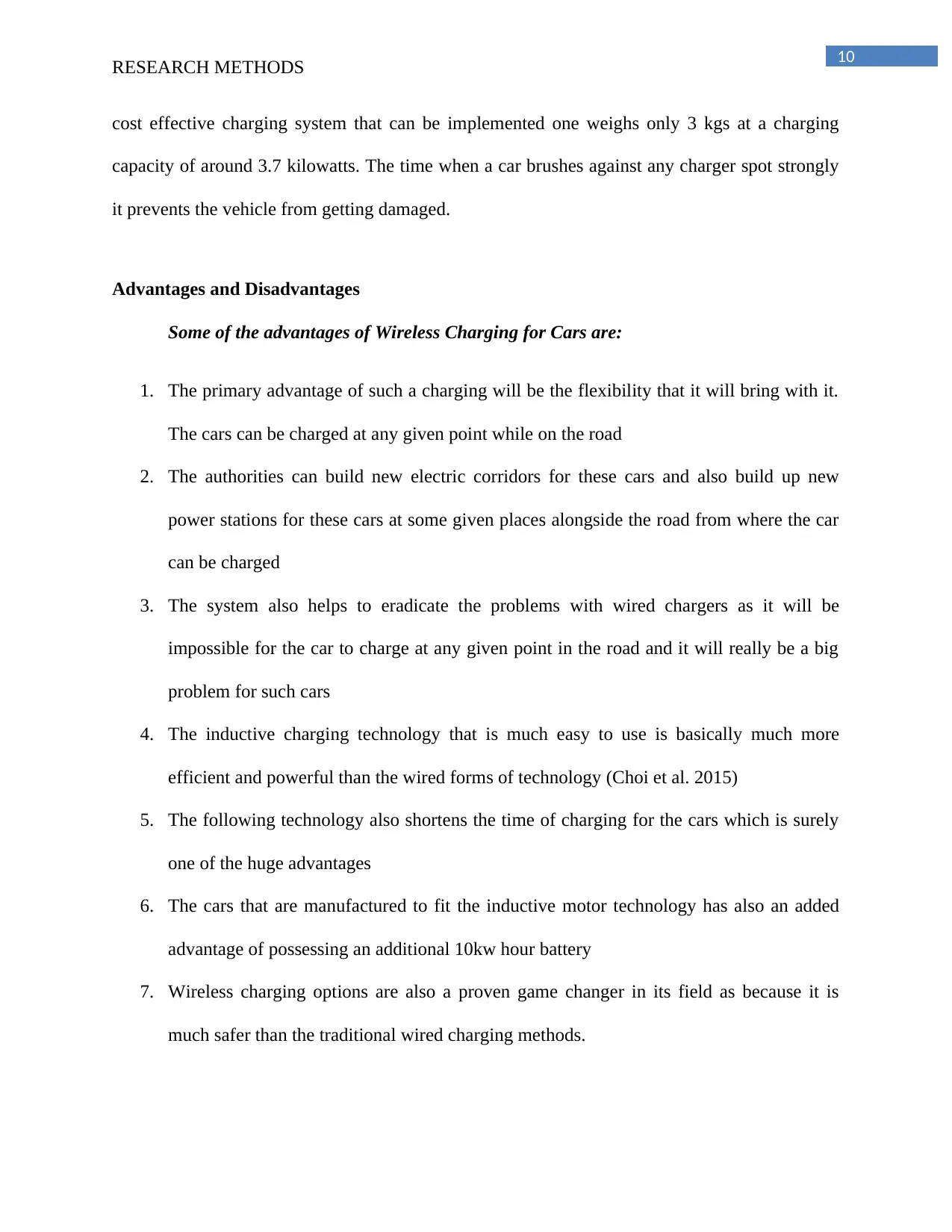
10
RESEARCH METHODS
cost effective charging system that can be implemented one weighs only 3 kgs at a charging
capacity of around 3.7 kilowatts. The time when a car brushes against any charger spot strongly
it prevents the vehicle from getting damaged.
Advantages and Disadvantages
Some of the advantages of Wireless Charging for Cars are:
1. The primary advantage of such a charging will be the flexibility that it will bring with it.
The cars can be charged at any given point while on the road
2. The authorities can build new electric corridors for these cars and also build up new
power stations for these cars at some given places alongside the road from where the car
can be charged
3. The system also helps to eradicate the problems with wired chargers as it will be
impossible for the car to charge at any given point in the road and it will really be a big
problem for such cars
4. The inductive charging technology that is much easy to use is basically much more
efficient and powerful than the wired forms of technology (Choi et al. 2015)
5. The following technology also shortens the time of charging for the cars which is surely
one of the huge advantages
6. The cars that are manufactured to fit the inductive motor technology has also an added
advantage of possessing an additional 10kw hour battery
7. Wireless charging options are also a proven game changer in its field as because it is
much safer than the traditional wired charging methods.
RESEARCH METHODS
cost effective charging system that can be implemented one weighs only 3 kgs at a charging
capacity of around 3.7 kilowatts. The time when a car brushes against any charger spot strongly
it prevents the vehicle from getting damaged.
Advantages and Disadvantages
Some of the advantages of Wireless Charging for Cars are:
1. The primary advantage of such a charging will be the flexibility that it will bring with it.
The cars can be charged at any given point while on the road
2. The authorities can build new electric corridors for these cars and also build up new
power stations for these cars at some given places alongside the road from where the car
can be charged
3. The system also helps to eradicate the problems with wired chargers as it will be
impossible for the car to charge at any given point in the road and it will really be a big
problem for such cars
4. The inductive charging technology that is much easy to use is basically much more
efficient and powerful than the wired forms of technology (Choi et al. 2015)
5. The following technology also shortens the time of charging for the cars which is surely
one of the huge advantages
6. The cars that are manufactured to fit the inductive motor technology has also an added
advantage of possessing an additional 10kw hour battery
7. Wireless charging options are also a proven game changer in its field as because it is
much safer than the traditional wired charging methods.
Secure Best Marks with AI Grader
Need help grading? Try our AI Grader for instant feedback on your assignments.
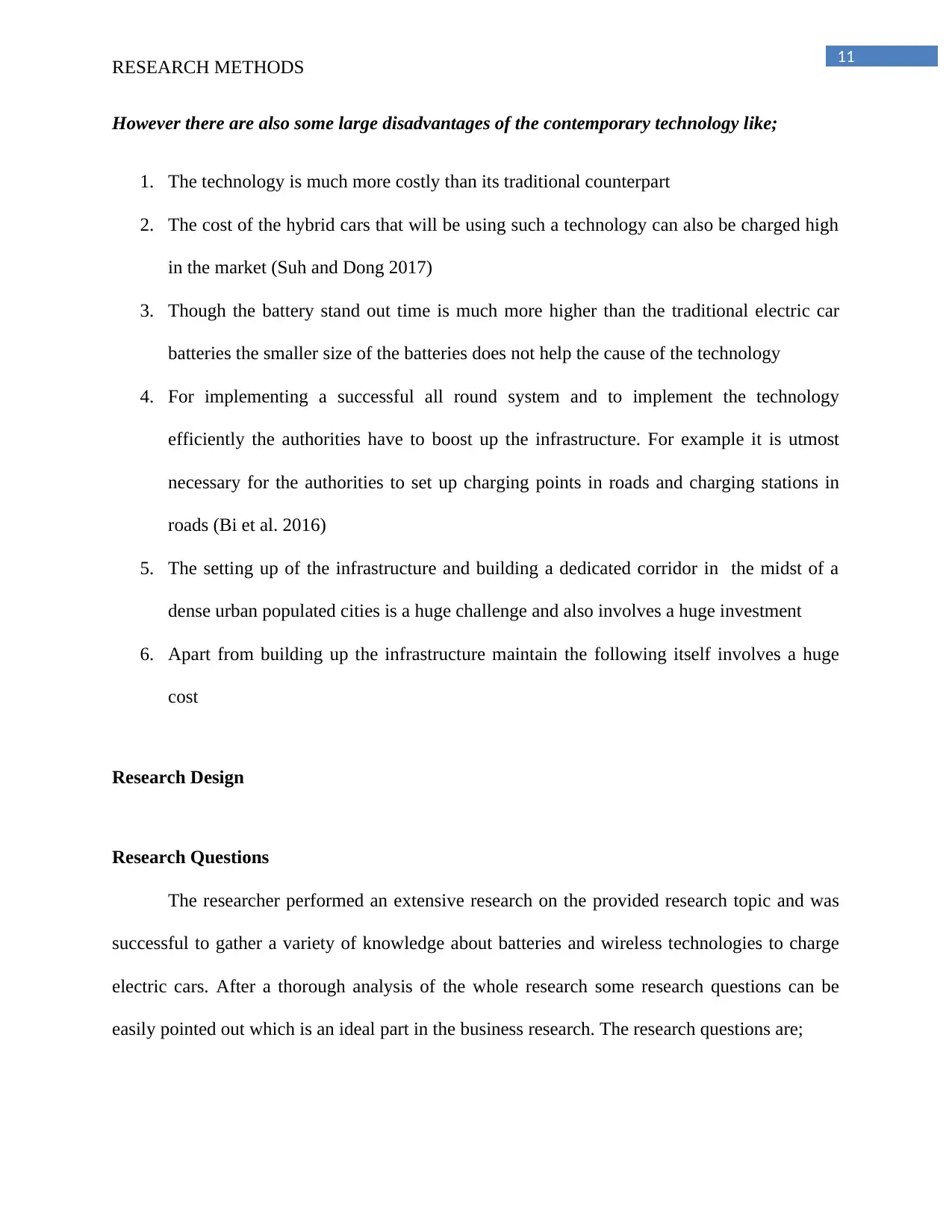
11
RESEARCH METHODS
However there are also some large disadvantages of the contemporary technology like;
1. The technology is much more costly than its traditional counterpart
2. The cost of the hybrid cars that will be using such a technology can also be charged high
in the market (Suh and Dong 2017)
3. Though the battery stand out time is much more higher than the traditional electric car
batteries the smaller size of the batteries does not help the cause of the technology
4. For implementing a successful all round system and to implement the technology
efficiently the authorities have to boost up the infrastructure. For example it is utmost
necessary for the authorities to set up charging points in roads and charging stations in
roads (Bi et al. 2016)
5. The setting up of the infrastructure and building a dedicated corridor in the midst of a
dense urban populated cities is a huge challenge and also involves a huge investment
6. Apart from building up the infrastructure maintain the following itself involves a huge
cost
Research Design
Research Questions
The researcher performed an extensive research on the provided research topic and was
successful to gather a variety of knowledge about batteries and wireless technologies to charge
electric cars. After a thorough analysis of the whole research some research questions can be
easily pointed out which is an ideal part in the business research. The research questions are;
RESEARCH METHODS
However there are also some large disadvantages of the contemporary technology like;
1. The technology is much more costly than its traditional counterpart
2. The cost of the hybrid cars that will be using such a technology can also be charged high
in the market (Suh and Dong 2017)
3. Though the battery stand out time is much more higher than the traditional electric car
batteries the smaller size of the batteries does not help the cause of the technology
4. For implementing a successful all round system and to implement the technology
efficiently the authorities have to boost up the infrastructure. For example it is utmost
necessary for the authorities to set up charging points in roads and charging stations in
roads (Bi et al. 2016)
5. The setting up of the infrastructure and building a dedicated corridor in the midst of a
dense urban populated cities is a huge challenge and also involves a huge investment
6. Apart from building up the infrastructure maintain the following itself involves a huge
cost
Research Design
Research Questions
The researcher performed an extensive research on the provided research topic and was
successful to gather a variety of knowledge about batteries and wireless technologies to charge
electric cars. After a thorough analysis of the whole research some research questions can be
easily pointed out which is an ideal part in the business research. The research questions are;

12
RESEARCH METHODS
A. What are the main characteristics of wireless charging of electric cars and how are
they helpful?
B. Is wireless charging of cars more beneficial than the wired chargers?
C. Mention some of the advantages and disadvantages of wireless charging?
D. What is the stand of the latest research that is being conducted in this particular field?
Research methodology
Qualitative Research
Qualitative Research is the type of research that is involved in the use of unreliable and
unstructured information sources and information, collection of different methods and careful
observations. It also includes the conduction of the research interviews, performing surveys and
collecting information from some documents (Shin et al. 2014). Basically it is that kind of
research that can be said to be a theoretical form of research involving a detailed analysis of the
necessary documents. The readers will be well aware of the origin of the research, the date of
occurrence, the topic of the research and the collection of the research methods. Some of the
steps in this particular kind of research include;
A. Deciding the research topic
B. Preparation of the research
C. Preparation of the research Questionnaire and giving special attention to it
D. Conducting the literature review of the research
E. Evaluating the need for such a research whether it is needed or not
F. Identifying the sample size
RESEARCH METHODS
A. What are the main characteristics of wireless charging of electric cars and how are
they helpful?
B. Is wireless charging of cars more beneficial than the wired chargers?
C. Mention some of the advantages and disadvantages of wireless charging?
D. What is the stand of the latest research that is being conducted in this particular field?
Research methodology
Qualitative Research
Qualitative Research is the type of research that is involved in the use of unreliable and
unstructured information sources and information, collection of different methods and careful
observations. It also includes the conduction of the research interviews, performing surveys and
collecting information from some documents (Shin et al. 2014). Basically it is that kind of
research that can be said to be a theoretical form of research involving a detailed analysis of the
necessary documents. The readers will be well aware of the origin of the research, the date of
occurrence, the topic of the research and the collection of the research methods. Some of the
steps in this particular kind of research include;
A. Deciding the research topic
B. Preparation of the research
C. Preparation of the research Questionnaire and giving special attention to it
D. Conducting the literature review of the research
E. Evaluating the need for such a research whether it is needed or not
F. Identifying the sample size
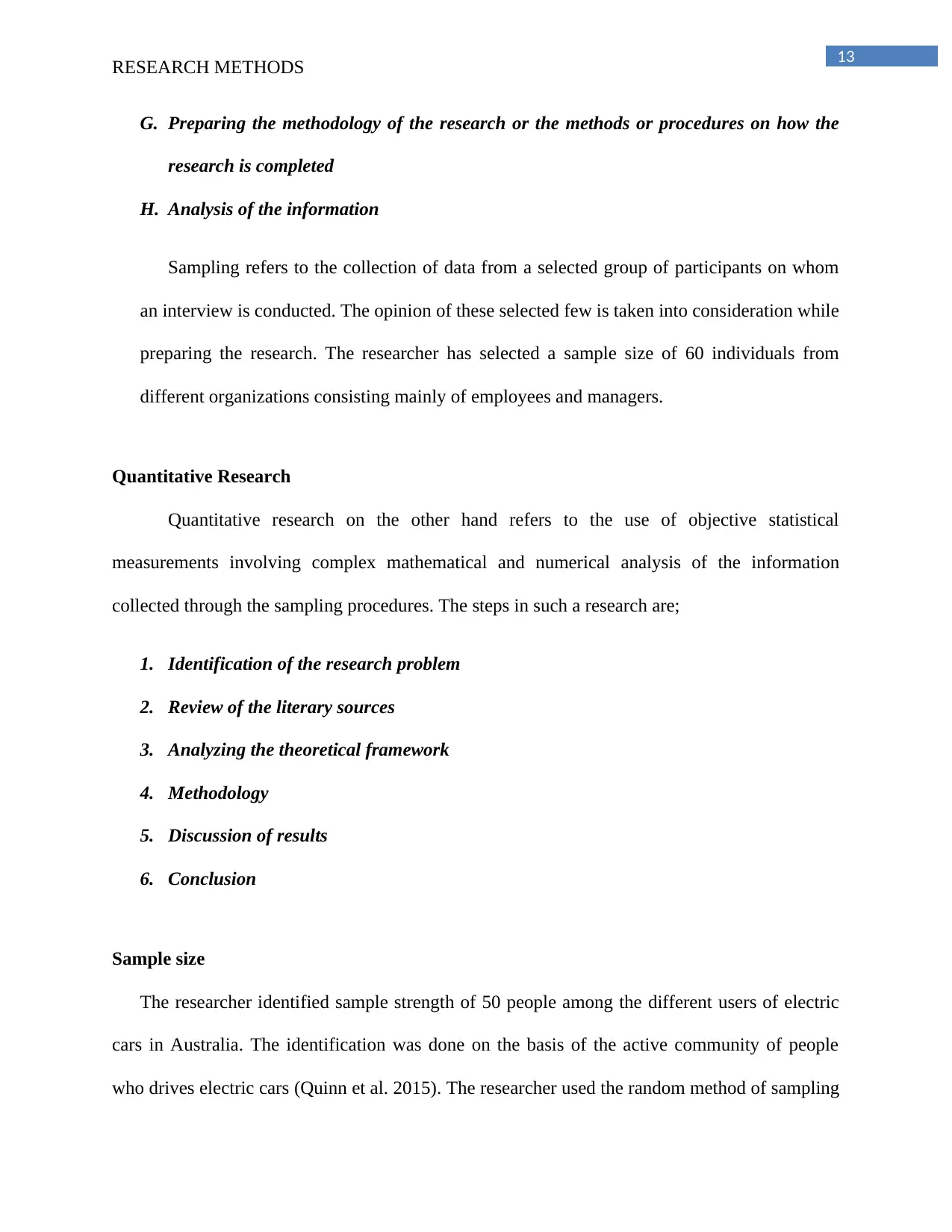
13
RESEARCH METHODS
G. Preparing the methodology of the research or the methods or procedures on how the
research is completed
H. Analysis of the information
Sampling refers to the collection of data from a selected group of participants on whom
an interview is conducted. The opinion of these selected few is taken into consideration while
preparing the research. The researcher has selected a sample size of 60 individuals from
different organizations consisting mainly of employees and managers.
Quantitative Research
Quantitative research on the other hand refers to the use of objective statistical
measurements involving complex mathematical and numerical analysis of the information
collected through the sampling procedures. The steps in such a research are;
1. Identification of the research problem
2. Review of the literary sources
3. Analyzing the theoretical framework
4. Methodology
5. Discussion of results
6. Conclusion
Sample size
The researcher identified sample strength of 50 people among the different users of electric
cars in Australia. The identification was done on the basis of the active community of people
who drives electric cars (Quinn et al. 2015). The researcher used the random method of sampling
RESEARCH METHODS
G. Preparing the methodology of the research or the methods or procedures on how the
research is completed
H. Analysis of the information
Sampling refers to the collection of data from a selected group of participants on whom
an interview is conducted. The opinion of these selected few is taken into consideration while
preparing the research. The researcher has selected a sample size of 60 individuals from
different organizations consisting mainly of employees and managers.
Quantitative Research
Quantitative research on the other hand refers to the use of objective statistical
measurements involving complex mathematical and numerical analysis of the information
collected through the sampling procedures. The steps in such a research are;
1. Identification of the research problem
2. Review of the literary sources
3. Analyzing the theoretical framework
4. Methodology
5. Discussion of results
6. Conclusion
Sample size
The researcher identified sample strength of 50 people among the different users of electric
cars in Australia. The identification was done on the basis of the active community of people
who drives electric cars (Quinn et al. 2015). The researcher used the random method of sampling
Paraphrase This Document
Need a fresh take? Get an instant paraphrase of this document with our AI Paraphraser
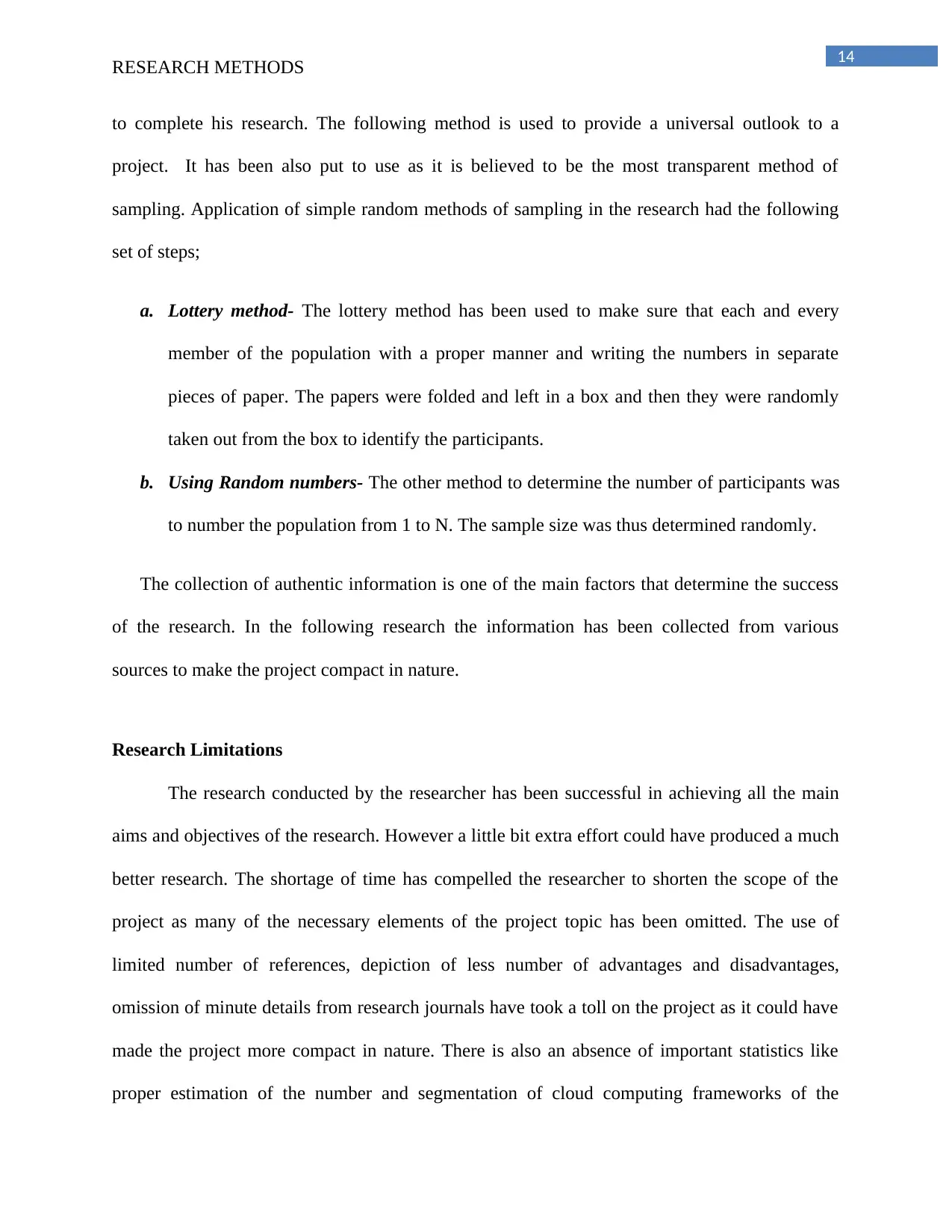
14
RESEARCH METHODS
to complete his research. The following method is used to provide a universal outlook to a
project. It has been also put to use as it is believed to be the most transparent method of
sampling. Application of simple random methods of sampling in the research had the following
set of steps;
a. Lottery method- The lottery method has been used to make sure that each and every
member of the population with a proper manner and writing the numbers in separate
pieces of paper. The papers were folded and left in a box and then they were randomly
taken out from the box to identify the participants.
b. Using Random numbers- The other method to determine the number of participants was
to number the population from 1 to N. The sample size was thus determined randomly.
The collection of authentic information is one of the main factors that determine the success
of the research. In the following research the information has been collected from various
sources to make the project compact in nature.
Research Limitations
The research conducted by the researcher has been successful in achieving all the main
aims and objectives of the research. However a little bit extra effort could have produced a much
better research. The shortage of time has compelled the researcher to shorten the scope of the
project as many of the necessary elements of the project topic has been omitted. The use of
limited number of references, depiction of less number of advantages and disadvantages,
omission of minute details from research journals have took a toll on the project as it could have
made the project more compact in nature. There is also an absence of important statistics like
proper estimation of the number and segmentation of cloud computing frameworks of the
RESEARCH METHODS
to complete his research. The following method is used to provide a universal outlook to a
project. It has been also put to use as it is believed to be the most transparent method of
sampling. Application of simple random methods of sampling in the research had the following
set of steps;
a. Lottery method- The lottery method has been used to make sure that each and every
member of the population with a proper manner and writing the numbers in separate
pieces of paper. The papers were folded and left in a box and then they were randomly
taken out from the box to identify the participants.
b. Using Random numbers- The other method to determine the number of participants was
to number the population from 1 to N. The sample size was thus determined randomly.
The collection of authentic information is one of the main factors that determine the success
of the research. In the following research the information has been collected from various
sources to make the project compact in nature.
Research Limitations
The research conducted by the researcher has been successful in achieving all the main
aims and objectives of the research. However a little bit extra effort could have produced a much
better research. The shortage of time has compelled the researcher to shorten the scope of the
project as many of the necessary elements of the project topic has been omitted. The use of
limited number of references, depiction of less number of advantages and disadvantages,
omission of minute details from research journals have took a toll on the project as it could have
made the project more compact in nature. There is also an absence of important statistics like
proper estimation of the number and segmentation of cloud computing frameworks of the
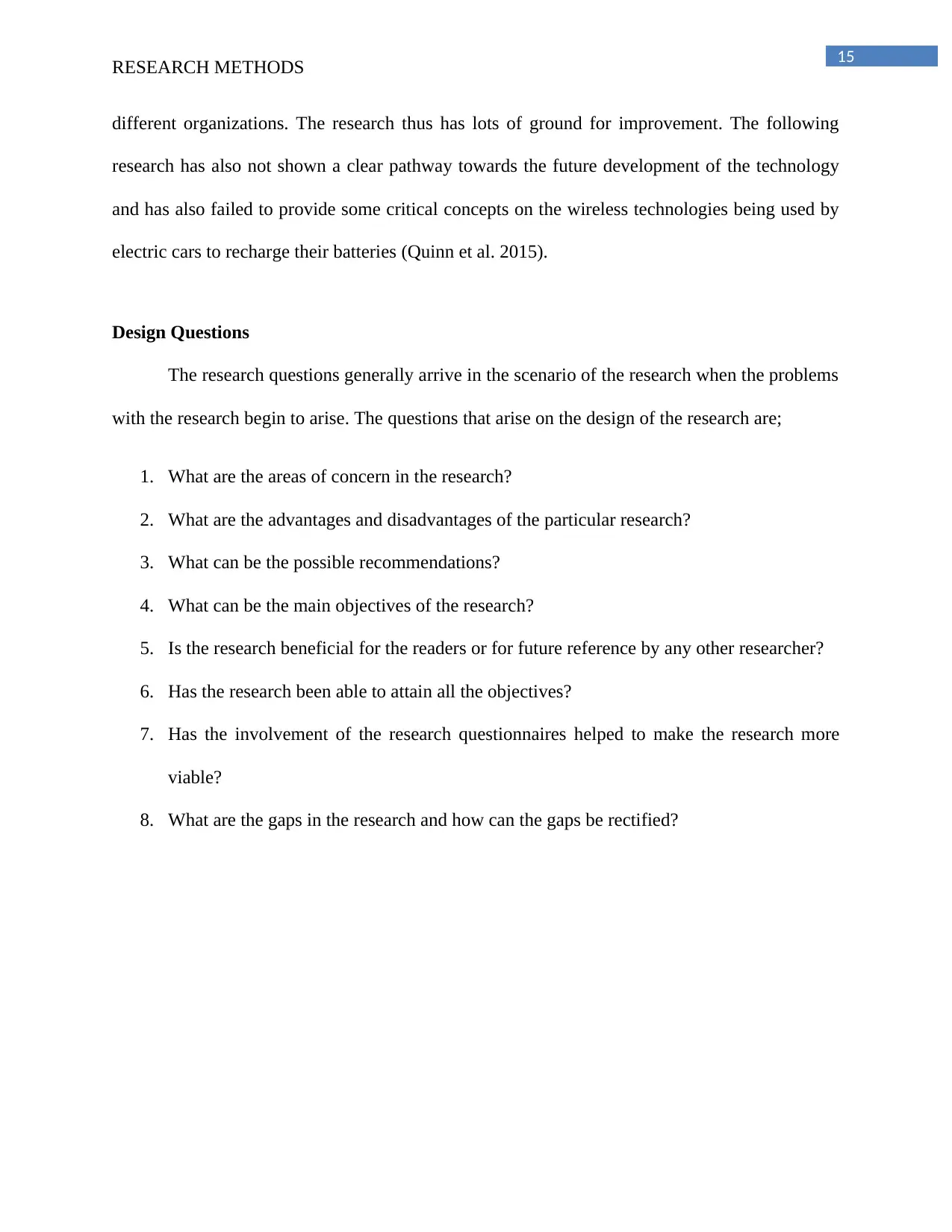
15
RESEARCH METHODS
different organizations. The research thus has lots of ground for improvement. The following
research has also not shown a clear pathway towards the future development of the technology
and has also failed to provide some critical concepts on the wireless technologies being used by
electric cars to recharge their batteries (Quinn et al. 2015).
Design Questions
The research questions generally arrive in the scenario of the research when the problems
with the research begin to arise. The questions that arise on the design of the research are;
1. What are the areas of concern in the research?
2. What are the advantages and disadvantages of the particular research?
3. What can be the possible recommendations?
4. What can be the main objectives of the research?
5. Is the research beneficial for the readers or for future reference by any other researcher?
6. Has the research been able to attain all the objectives?
7. Has the involvement of the research questionnaires helped to make the research more
viable?
8. What are the gaps in the research and how can the gaps be rectified?
RESEARCH METHODS
different organizations. The research thus has lots of ground for improvement. The following
research has also not shown a clear pathway towards the future development of the technology
and has also failed to provide some critical concepts on the wireless technologies being used by
electric cars to recharge their batteries (Quinn et al. 2015).
Design Questions
The research questions generally arrive in the scenario of the research when the problems
with the research begin to arise. The questions that arise on the design of the research are;
1. What are the areas of concern in the research?
2. What are the advantages and disadvantages of the particular research?
3. What can be the possible recommendations?
4. What can be the main objectives of the research?
5. Is the research beneficial for the readers or for future reference by any other researcher?
6. Has the research been able to attain all the objectives?
7. Has the involvement of the research questionnaires helped to make the research more
viable?
8. What are the gaps in the research and how can the gaps be rectified?
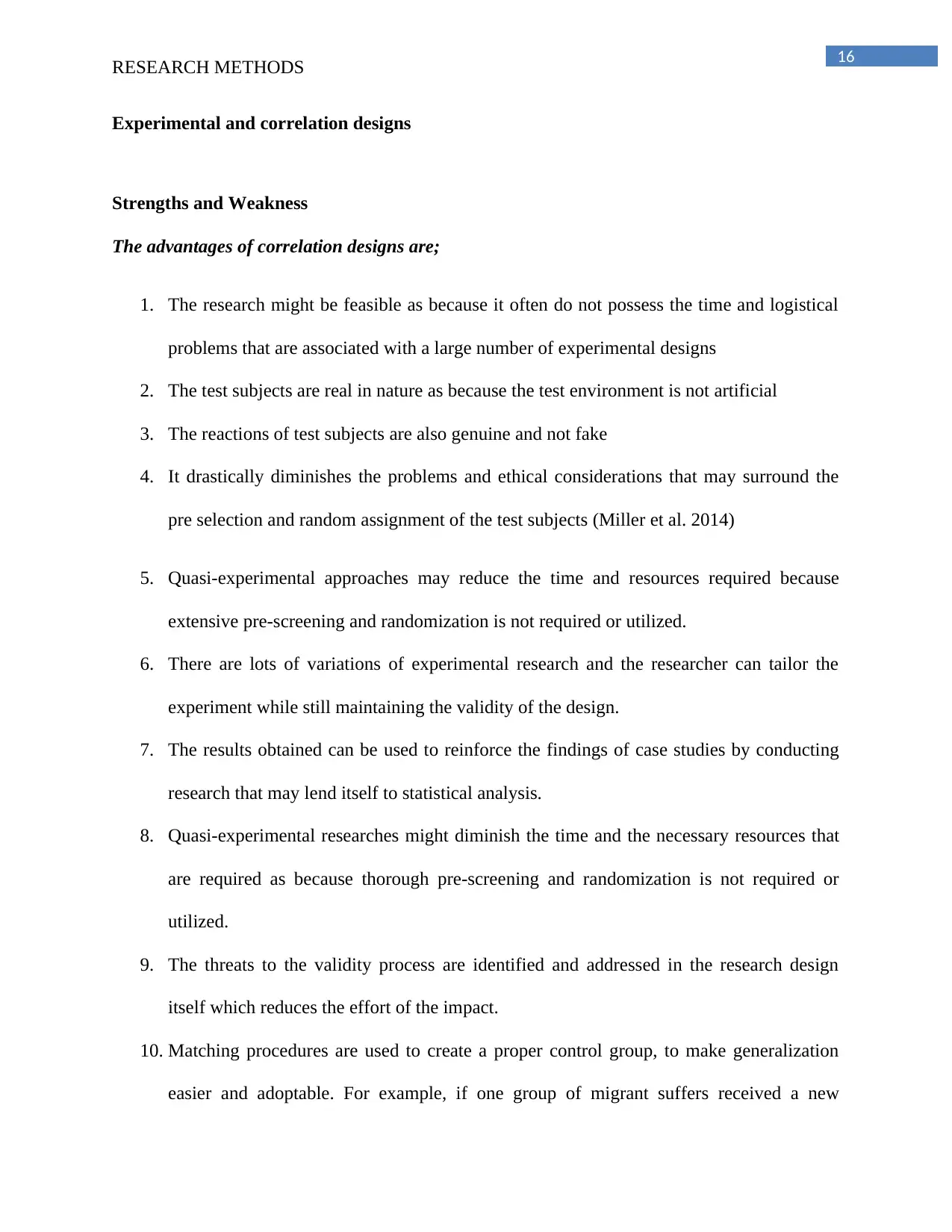
16
RESEARCH METHODS
Experimental and correlation designs
Strengths and Weakness
The advantages of correlation designs are;
1. The research might be feasible as because it often do not possess the time and logistical
problems that are associated with a large number of experimental designs
2. The test subjects are real in nature as because the test environment is not artificial
3. The reactions of test subjects are also genuine and not fake
4. It drastically diminishes the problems and ethical considerations that may surround the
pre selection and random assignment of the test subjects (Miller et al. 2014)
5. Quasi-experimental approaches may reduce the time and resources required because
extensive pre-screening and randomization is not required or utilized.
6. There are lots of variations of experimental research and the researcher can tailor the
experiment while still maintaining the validity of the design.
7. The results obtained can be used to reinforce the findings of case studies by conducting
research that may lend itself to statistical analysis.
8. Quasi-experimental researches might diminish the time and the necessary resources that
are required as because thorough pre-screening and randomization is not required or
utilized.
9. The threats to the validity process are identified and addressed in the research design
itself which reduces the effort of the impact.
10. Matching procedures are used to create a proper control group, to make generalization
easier and adoptable. For example, if one group of migrant suffers received a new
RESEARCH METHODS
Experimental and correlation designs
Strengths and Weakness
The advantages of correlation designs are;
1. The research might be feasible as because it often do not possess the time and logistical
problems that are associated with a large number of experimental designs
2. The test subjects are real in nature as because the test environment is not artificial
3. The reactions of test subjects are also genuine and not fake
4. It drastically diminishes the problems and ethical considerations that may surround the
pre selection and random assignment of the test subjects (Miller et al. 2014)
5. Quasi-experimental approaches may reduce the time and resources required because
extensive pre-screening and randomization is not required or utilized.
6. There are lots of variations of experimental research and the researcher can tailor the
experiment while still maintaining the validity of the design.
7. The results obtained can be used to reinforce the findings of case studies by conducting
research that may lend itself to statistical analysis.
8. Quasi-experimental researches might diminish the time and the necessary resources that
are required as because thorough pre-screening and randomization is not required or
utilized.
9. The threats to the validity process are identified and addressed in the research design
itself which reduces the effort of the impact.
10. Matching procedures are used to create a proper control group, to make generalization
easier and adoptable. For example, if one group of migrant suffers received a new
Secure Best Marks with AI Grader
Need help grading? Try our AI Grader for instant feedback on your assignments.
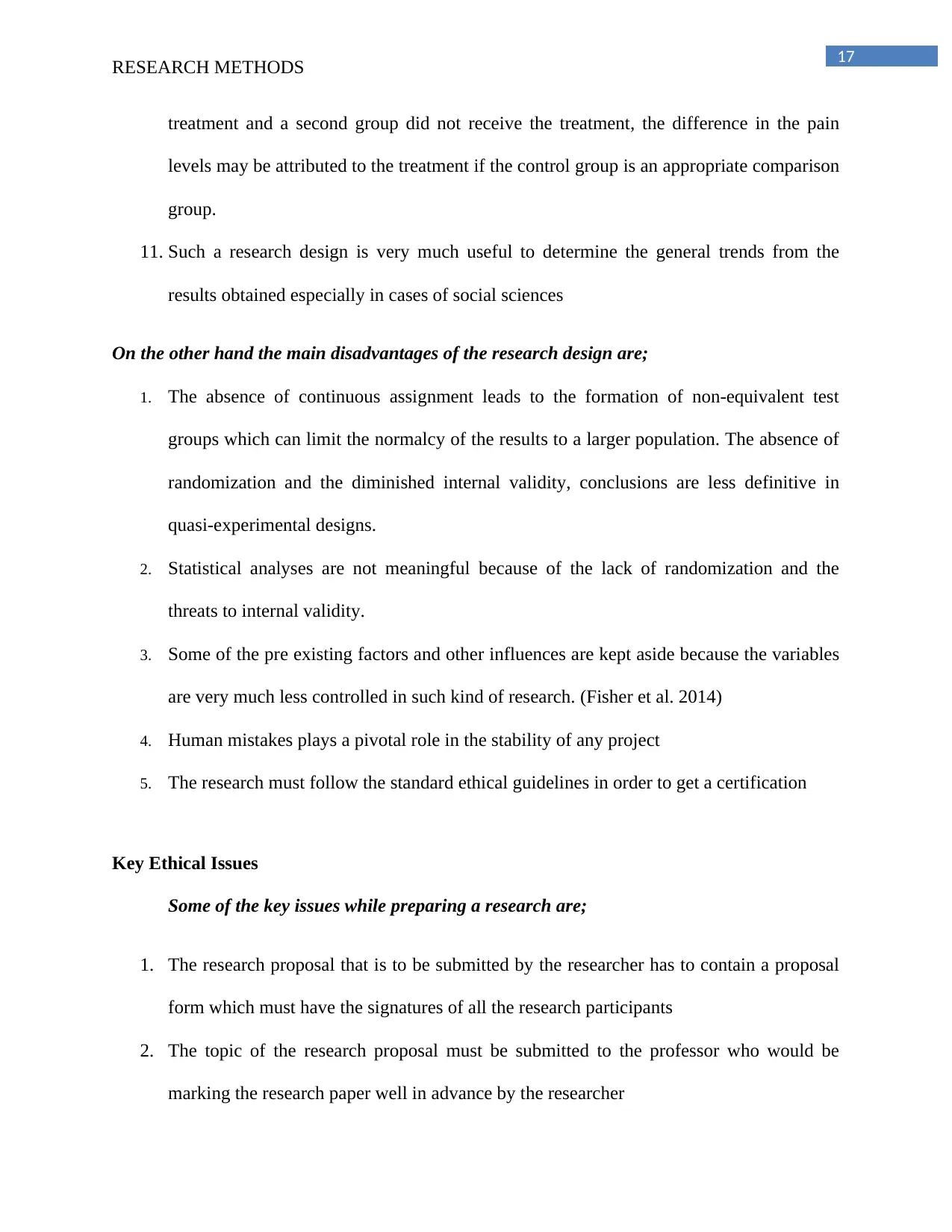
17
RESEARCH METHODS
treatment and a second group did not receive the treatment, the difference in the pain
levels may be attributed to the treatment if the control group is an appropriate comparison
group.
11. Such a research design is very much useful to determine the general trends from the
results obtained especially in cases of social sciences
On the other hand the main disadvantages of the research design are;
1. The absence of continuous assignment leads to the formation of non-equivalent test
groups which can limit the normalcy of the results to a larger population. The absence of
randomization and the diminished internal validity, conclusions are less definitive in
quasi-experimental designs.
2. Statistical analyses are not meaningful because of the lack of randomization and the
threats to internal validity.
3. Some of the pre existing factors and other influences are kept aside because the variables
are very much less controlled in such kind of research. (Fisher et al. 2014)
4. Human mistakes plays a pivotal role in the stability of any project
5. The research must follow the standard ethical guidelines in order to get a certification
Key Ethical Issues
Some of the key issues while preparing a research are;
1. The research proposal that is to be submitted by the researcher has to contain a proposal
form which must have the signatures of all the research participants
2. The topic of the research proposal must be submitted to the professor who would be
marking the research paper well in advance by the researcher
RESEARCH METHODS
treatment and a second group did not receive the treatment, the difference in the pain
levels may be attributed to the treatment if the control group is an appropriate comparison
group.
11. Such a research design is very much useful to determine the general trends from the
results obtained especially in cases of social sciences
On the other hand the main disadvantages of the research design are;
1. The absence of continuous assignment leads to the formation of non-equivalent test
groups which can limit the normalcy of the results to a larger population. The absence of
randomization and the diminished internal validity, conclusions are less definitive in
quasi-experimental designs.
2. Statistical analyses are not meaningful because of the lack of randomization and the
threats to internal validity.
3. Some of the pre existing factors and other influences are kept aside because the variables
are very much less controlled in such kind of research. (Fisher et al. 2014)
4. Human mistakes plays a pivotal role in the stability of any project
5. The research must follow the standard ethical guidelines in order to get a certification
Key Ethical Issues
Some of the key issues while preparing a research are;
1. The research proposal that is to be submitted by the researcher has to contain a proposal
form which must have the signatures of all the research participants
2. The topic of the research proposal must be submitted to the professor who would be
marking the research paper well in advance by the researcher
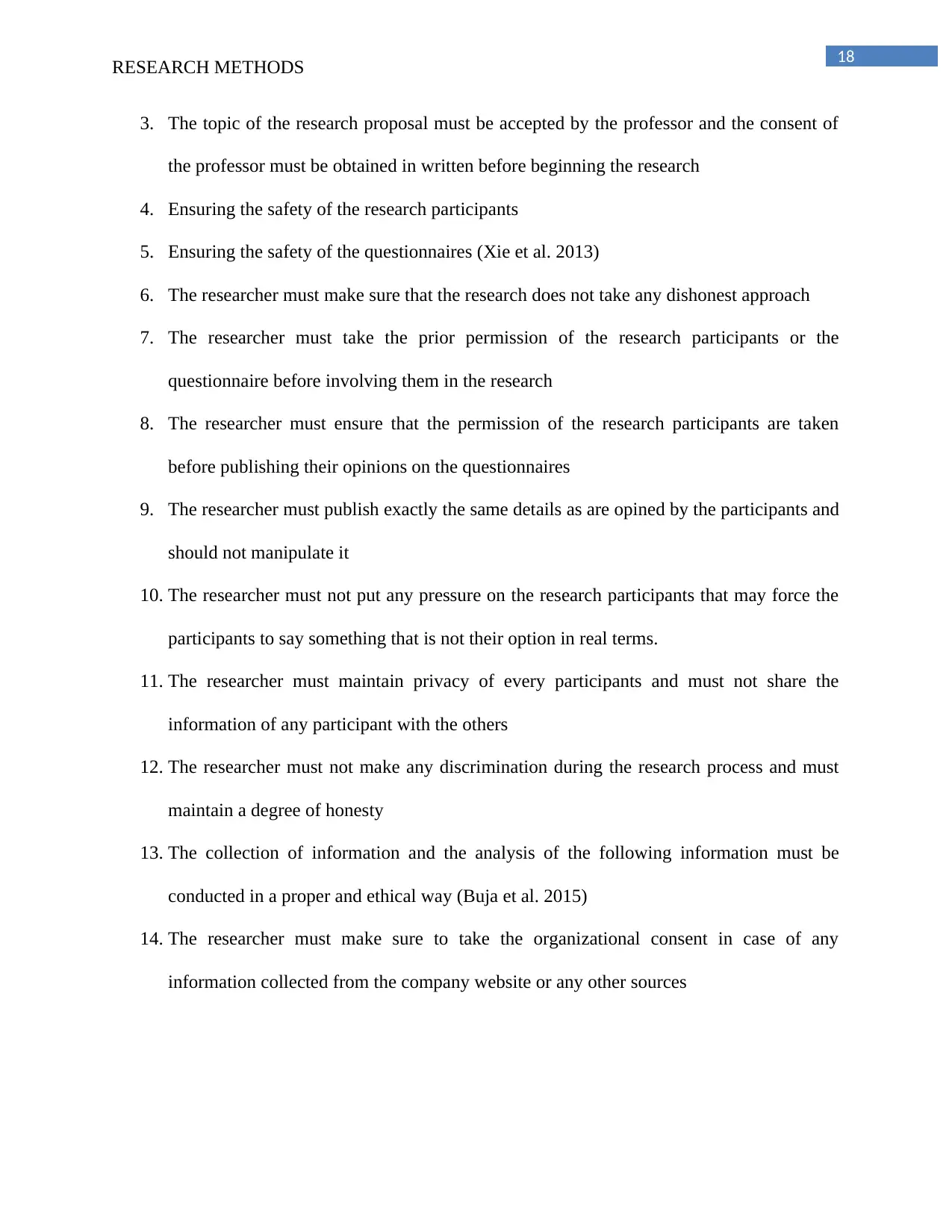
18
RESEARCH METHODS
3. The topic of the research proposal must be accepted by the professor and the consent of
the professor must be obtained in written before beginning the research
4. Ensuring the safety of the research participants
5. Ensuring the safety of the questionnaires (Xie et al. 2013)
6. The researcher must make sure that the research does not take any dishonest approach
7. The researcher must take the prior permission of the research participants or the
questionnaire before involving them in the research
8. The researcher must ensure that the permission of the research participants are taken
before publishing their opinions on the questionnaires
9. The researcher must publish exactly the same details as are opined by the participants and
should not manipulate it
10. The researcher must not put any pressure on the research participants that may force the
participants to say something that is not their option in real terms.
11. The researcher must maintain privacy of every participants and must not share the
information of any participant with the others
12. The researcher must not make any discrimination during the research process and must
maintain a degree of honesty
13. The collection of information and the analysis of the following information must be
conducted in a proper and ethical way (Buja et al. 2015)
14. The researcher must make sure to take the organizational consent in case of any
information collected from the company website or any other sources
RESEARCH METHODS
3. The topic of the research proposal must be accepted by the professor and the consent of
the professor must be obtained in written before beginning the research
4. Ensuring the safety of the research participants
5. Ensuring the safety of the questionnaires (Xie et al. 2013)
6. The researcher must make sure that the research does not take any dishonest approach
7. The researcher must take the prior permission of the research participants or the
questionnaire before involving them in the research
8. The researcher must ensure that the permission of the research participants are taken
before publishing their opinions on the questionnaires
9. The researcher must publish exactly the same details as are opined by the participants and
should not manipulate it
10. The researcher must not put any pressure on the research participants that may force the
participants to say something that is not their option in real terms.
11. The researcher must maintain privacy of every participants and must not share the
information of any participant with the others
12. The researcher must not make any discrimination during the research process and must
maintain a degree of honesty
13. The collection of information and the analysis of the following information must be
conducted in a proper and ethical way (Buja et al. 2015)
14. The researcher must make sure to take the organizational consent in case of any
information collected from the company website or any other sources
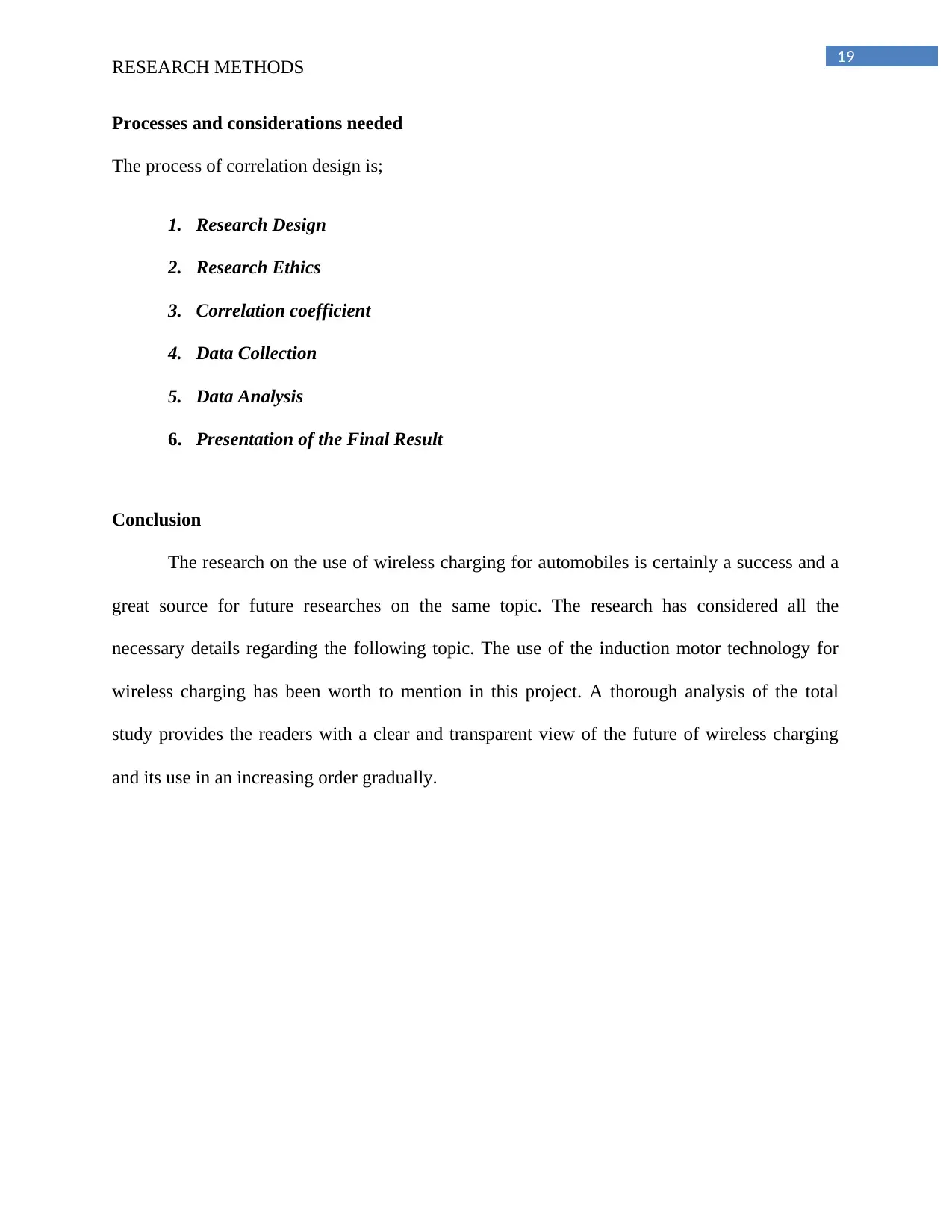
19
RESEARCH METHODS
Processes and considerations needed
The process of correlation design is;
1. Research Design
2. Research Ethics
3. Correlation coefficient
4. Data Collection
5. Data Analysis
6. Presentation of the Final Result
Conclusion
The research on the use of wireless charging for automobiles is certainly a success and a
great source for future researches on the same topic. The research has considered all the
necessary details regarding the following topic. The use of the induction motor technology for
wireless charging has been worth to mention in this project. A thorough analysis of the total
study provides the readers with a clear and transparent view of the future of wireless charging
and its use in an increasing order gradually.
RESEARCH METHODS
Processes and considerations needed
The process of correlation design is;
1. Research Design
2. Research Ethics
3. Correlation coefficient
4. Data Collection
5. Data Analysis
6. Presentation of the Final Result
Conclusion
The research on the use of wireless charging for automobiles is certainly a success and a
great source for future researches on the same topic. The research has considered all the
necessary details regarding the following topic. The use of the induction motor technology for
wireless charging has been worth to mention in this project. A thorough analysis of the total
study provides the readers with a clear and transparent view of the future of wireless charging
and its use in an increasing order gradually.
Paraphrase This Document
Need a fresh take? Get an instant paraphrase of this document with our AI Paraphraser
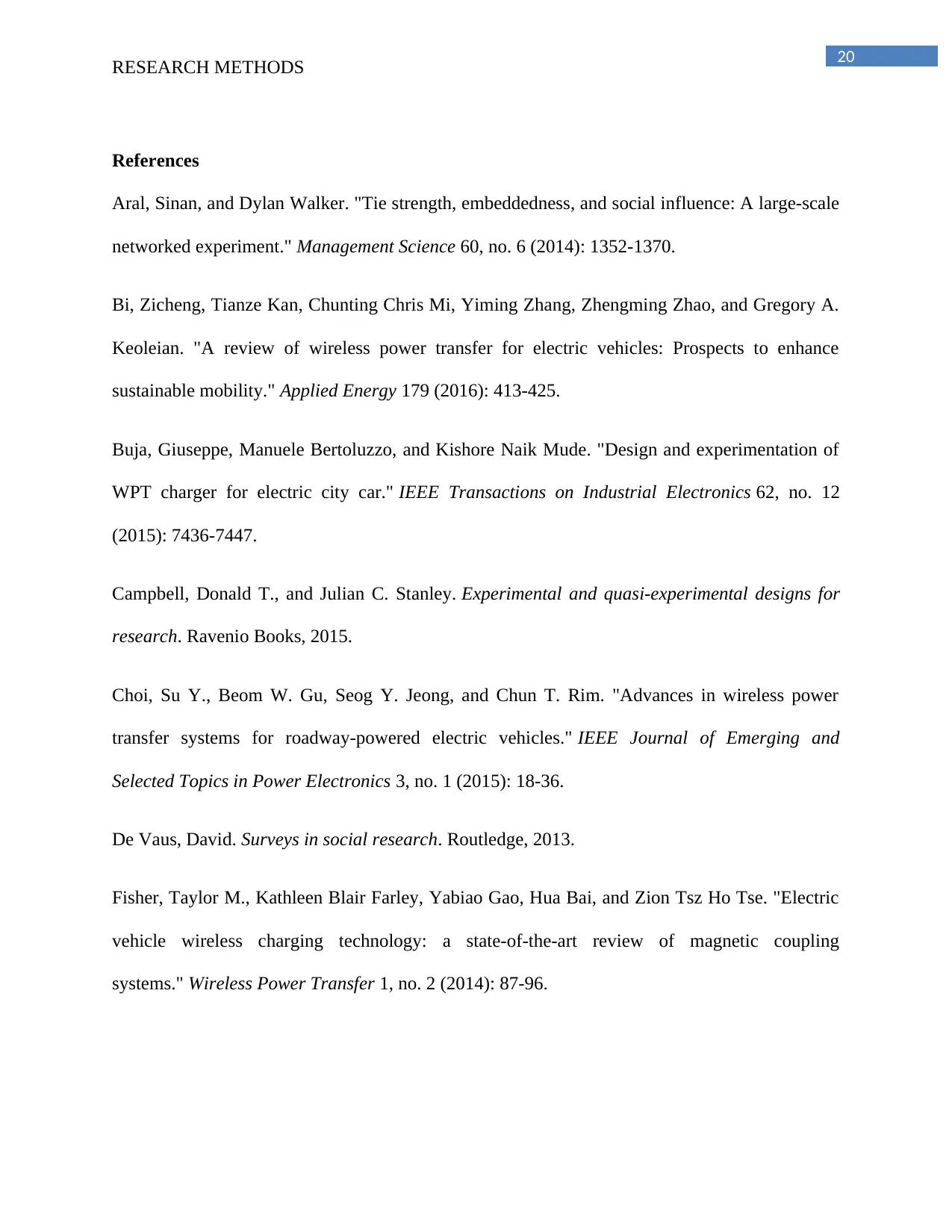
20
RESEARCH METHODS
References
Aral, Sinan, and Dylan Walker. "Tie strength, embeddedness, and social influence: A large-scale
networked experiment." Management Science 60, no. 6 (2014): 1352-1370.
Bi, Zicheng, Tianze Kan, Chunting Chris Mi, Yiming Zhang, Zhengming Zhao, and Gregory A.
Keoleian. "A review of wireless power transfer for electric vehicles: Prospects to enhance
sustainable mobility." Applied Energy 179 (2016): 413-425.
Buja, Giuseppe, Manuele Bertoluzzo, and Kishore Naik Mude. "Design and experimentation of
WPT charger for electric city car." IEEE Transactions on Industrial Electronics 62, no. 12
(2015): 7436-7447.
Campbell, Donald T., and Julian C. Stanley. Experimental and quasi-experimental designs for
research. Ravenio Books, 2015.
Choi, Su Y., Beom W. Gu, Seog Y. Jeong, and Chun T. Rim. "Advances in wireless power
transfer systems for roadway-powered electric vehicles." IEEE Journal of Emerging and
Selected Topics in Power Electronics 3, no. 1 (2015): 18-36.
De Vaus, David. Surveys in social research. Routledge, 2013.
Fisher, Taylor M., Kathleen Blair Farley, Yabiao Gao, Hua Bai, and Zion Tsz Ho Tse. "Electric
vehicle wireless charging technology: a state-of-the-art review of magnetic coupling
systems." Wireless Power Transfer 1, no. 2 (2014): 87-96.
RESEARCH METHODS
References
Aral, Sinan, and Dylan Walker. "Tie strength, embeddedness, and social influence: A large-scale
networked experiment." Management Science 60, no. 6 (2014): 1352-1370.
Bi, Zicheng, Tianze Kan, Chunting Chris Mi, Yiming Zhang, Zhengming Zhao, and Gregory A.
Keoleian. "A review of wireless power transfer for electric vehicles: Prospects to enhance
sustainable mobility." Applied Energy 179 (2016): 413-425.
Buja, Giuseppe, Manuele Bertoluzzo, and Kishore Naik Mude. "Design and experimentation of
WPT charger for electric city car." IEEE Transactions on Industrial Electronics 62, no. 12
(2015): 7436-7447.
Campbell, Donald T., and Julian C. Stanley. Experimental and quasi-experimental designs for
research. Ravenio Books, 2015.
Choi, Su Y., Beom W. Gu, Seog Y. Jeong, and Chun T. Rim. "Advances in wireless power
transfer systems for roadway-powered electric vehicles." IEEE Journal of Emerging and
Selected Topics in Power Electronics 3, no. 1 (2015): 18-36.
De Vaus, David. Surveys in social research. Routledge, 2013.
Fisher, Taylor M., Kathleen Blair Farley, Yabiao Gao, Hua Bai, and Zion Tsz Ho Tse. "Electric
vehicle wireless charging technology: a state-of-the-art review of magnetic coupling
systems." Wireless Power Transfer 1, no. 2 (2014): 87-96.
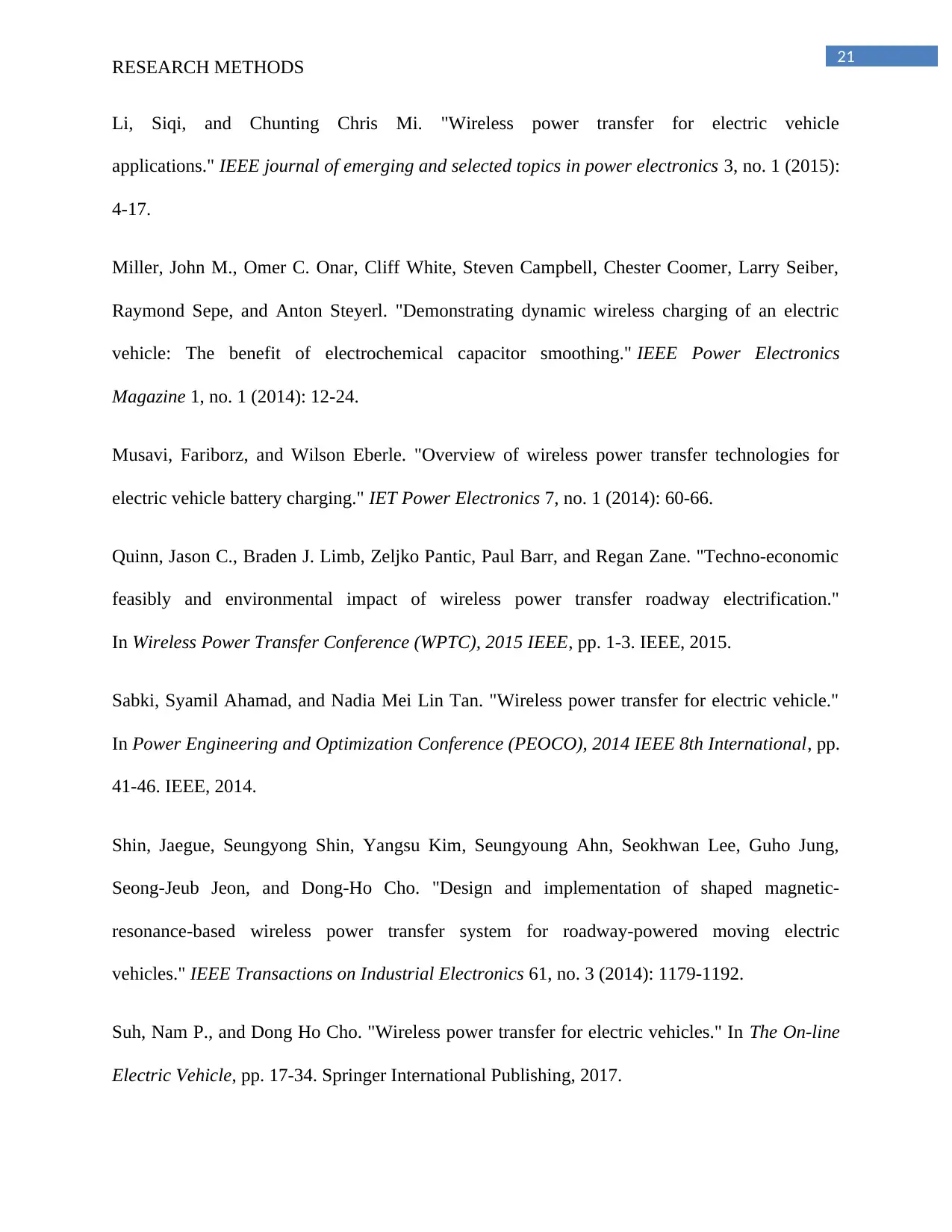
21
RESEARCH METHODS
Li, Siqi, and Chunting Chris Mi. "Wireless power transfer for electric vehicle
applications." IEEE journal of emerging and selected topics in power electronics 3, no. 1 (2015):
4-17.
Miller, John M., Omer C. Onar, Cliff White, Steven Campbell, Chester Coomer, Larry Seiber,
Raymond Sepe, and Anton Steyerl. "Demonstrating dynamic wireless charging of an electric
vehicle: The benefit of electrochemical capacitor smoothing." IEEE Power Electronics
Magazine 1, no. 1 (2014): 12-24.
Musavi, Fariborz, and Wilson Eberle. "Overview of wireless power transfer technologies for
electric vehicle battery charging." IET Power Electronics 7, no. 1 (2014): 60-66.
Quinn, Jason C., Braden J. Limb, Zeljko Pantic, Paul Barr, and Regan Zane. "Techno-economic
feasibly and environmental impact of wireless power transfer roadway electrification."
In Wireless Power Transfer Conference (WPTC), 2015 IEEE, pp. 1-3. IEEE, 2015.
Sabki, Syamil Ahamad, and Nadia Mei Lin Tan. "Wireless power transfer for electric vehicle."
In Power Engineering and Optimization Conference (PEOCO), 2014 IEEE 8th International, pp.
41-46. IEEE, 2014.
Shin, Jaegue, Seungyong Shin, Yangsu Kim, Seungyoung Ahn, Seokhwan Lee, Guho Jung,
Seong-Jeub Jeon, and Dong-Ho Cho. "Design and implementation of shaped magnetic-
resonance-based wireless power transfer system for roadway-powered moving electric
vehicles." IEEE Transactions on Industrial Electronics 61, no. 3 (2014): 1179-1192.
Suh, Nam P., and Dong Ho Cho. "Wireless power transfer for electric vehicles." In The On-line
Electric Vehicle, pp. 17-34. Springer International Publishing, 2017.
RESEARCH METHODS
Li, Siqi, and Chunting Chris Mi. "Wireless power transfer for electric vehicle
applications." IEEE journal of emerging and selected topics in power electronics 3, no. 1 (2015):
4-17.
Miller, John M., Omer C. Onar, Cliff White, Steven Campbell, Chester Coomer, Larry Seiber,
Raymond Sepe, and Anton Steyerl. "Demonstrating dynamic wireless charging of an electric
vehicle: The benefit of electrochemical capacitor smoothing." IEEE Power Electronics
Magazine 1, no. 1 (2014): 12-24.
Musavi, Fariborz, and Wilson Eberle. "Overview of wireless power transfer technologies for
electric vehicle battery charging." IET Power Electronics 7, no. 1 (2014): 60-66.
Quinn, Jason C., Braden J. Limb, Zeljko Pantic, Paul Barr, and Regan Zane. "Techno-economic
feasibly and environmental impact of wireless power transfer roadway electrification."
In Wireless Power Transfer Conference (WPTC), 2015 IEEE, pp. 1-3. IEEE, 2015.
Sabki, Syamil Ahamad, and Nadia Mei Lin Tan. "Wireless power transfer for electric vehicle."
In Power Engineering and Optimization Conference (PEOCO), 2014 IEEE 8th International, pp.
41-46. IEEE, 2014.
Shin, Jaegue, Seungyong Shin, Yangsu Kim, Seungyoung Ahn, Seokhwan Lee, Guho Jung,
Seong-Jeub Jeon, and Dong-Ho Cho. "Design and implementation of shaped magnetic-
resonance-based wireless power transfer system for roadway-powered moving electric
vehicles." IEEE Transactions on Industrial Electronics 61, no. 3 (2014): 1179-1192.
Suh, Nam P., and Dong Ho Cho. "Wireless power transfer for electric vehicles." In The On-line
Electric Vehicle, pp. 17-34. Springer International Publishing, 2017.

22
RESEARCH METHODS
Wildemuth, Barbara M., ed. Applications of social research methods to questions in information
and library science. ABC-CLIO, 2016.
Xie, Liguang, Yi Shi, Y. Thomas Hou, and Andwenjing Lou. "Wireless power transfer and
applications to sensor networks." IEEE Wireless Communications 20, no. 4 (2013): 140-145.
RESEARCH METHODS
Wildemuth, Barbara M., ed. Applications of social research methods to questions in information
and library science. ABC-CLIO, 2016.
Xie, Liguang, Yi Shi, Y. Thomas Hou, and Andwenjing Lou. "Wireless power transfer and
applications to sensor networks." IEEE Wireless Communications 20, no. 4 (2013): 140-145.
Secure Best Marks with AI Grader
Need help grading? Try our AI Grader for instant feedback on your assignments.

23
RESEARCH METHODS
Appendix
Figure 1- Inductive Charging Technologies
Source- (Campbell, Donald and Julian 2015)
RESEARCH METHODS
Appendix
Figure 1- Inductive Charging Technologies
Source- (Campbell, Donald and Julian 2015)
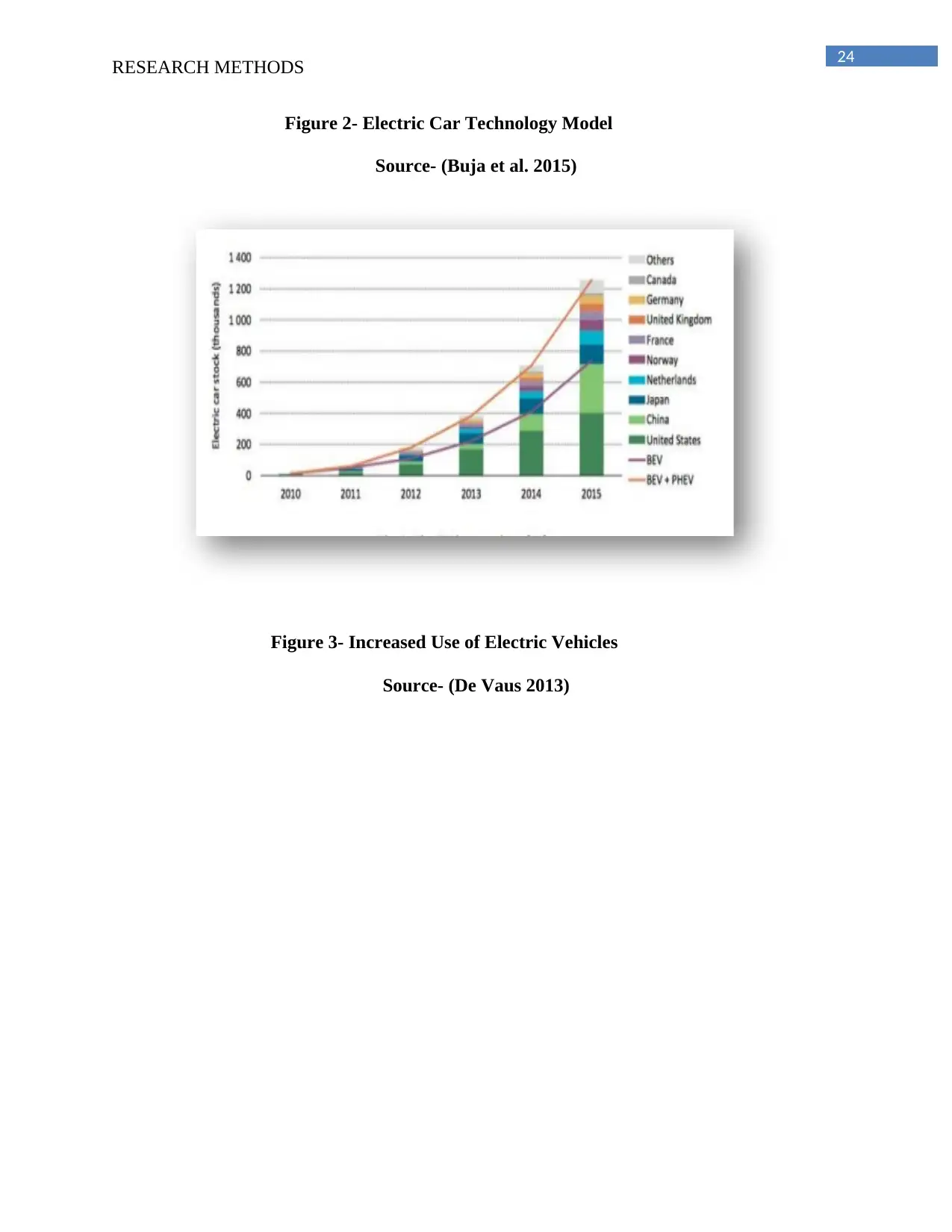
24
RESEARCH METHODS
Figure 2- Electric Car Technology Model
Source- (Buja et al. 2015)
Figure 3- Increased Use of Electric Vehicles
Source- (De Vaus 2013)
RESEARCH METHODS
Figure 2- Electric Car Technology Model
Source- (Buja et al. 2015)
Figure 3- Increased Use of Electric Vehicles
Source- (De Vaus 2013)
1 out of 24
Related Documents
Your All-in-One AI-Powered Toolkit for Academic Success.
+13062052269
info@desklib.com
Available 24*7 on WhatsApp / Email
![[object Object]](/_next/static/media/star-bottom.7253800d.svg)
Unlock your academic potential
© 2024 | Zucol Services PVT LTD | All rights reserved.





